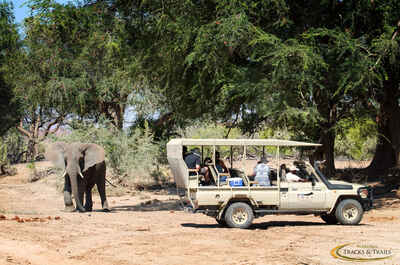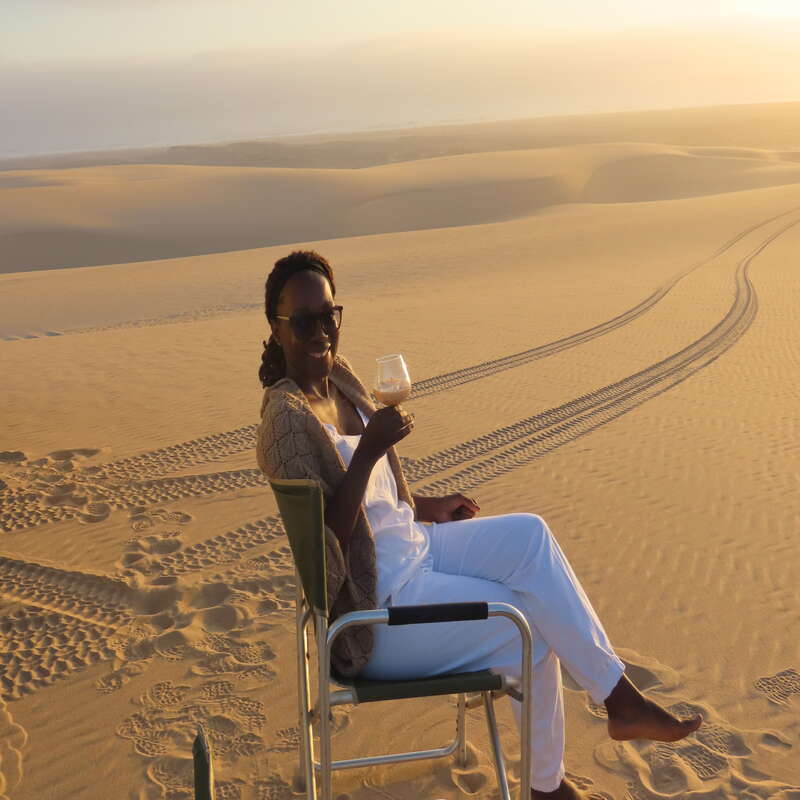About Ozondjou Trails
Ozondjou Trails may suggest walking, but the camp’s focus – on Namibia’s desert-adapted elephants – is far more complex.
After just two nights spent here, you’ll leave with a clearer understanding of these extraordinary animals, and of the challenges they present to farmers trying to make a living in the surrounding villages.
Right from the start, you’ll be introduced to members of the community, both on a local farm and – in term time – at a nearby school. These are the families who live alongside the elephants and who are crucial to the animals’ survival.
The following day, you’ll link up with a team from the NGO Elephant Human Relations Aid (EHRA) while they’re out and about tracking and studying Damaraland’s elephants – from bulls on musth to matriarchal herds roaming the ephemeral riverbeds in search of food and water.
The chances are that you’ll spot plenty of other wildlife too. Oryx and kudu, ostrich and giraffe: they too are well adapted to life in this arid landscape.
The camp itself is simple, its tented rooms stripped back to the essentials, yet with comfortable beds, en-suite hot showers, and surprisingly delicious meals. With short walks, picnic lunches, sundowners and dinner under the stars, you’ll find yourself immersed not just in the culture but also in the landscape. It’s a memorable place.
Our view
Although Ozondjou Trails is a permanent camp, the style, from its simple tents to the relaxed hosting, gives it a stripped back, intimate safari experience akin to camping out in one of Namibia’s wilder areas. The focus here is firmly on the surrounding wilderness and its nomadic desert-adapted wildlife, especially elephants.
Accommodation
9 twin tents
Children
Only for 16+
Open
15 Jan to 15 Dec
Activities

4WD Safari

Birdwatching

Cultural excursion

Guided walking safari

Private activities
Traveller reviews of Ozondjou Trails
3 real, un-edited reviews from Expert Africa's travellers.
Arrived 16 Sep 2022, 2 nights
"Ozondjou Trails review"
Overall rating: Excellent
Arrived 22 May 2019, 2 nights
"Elephantine experience"
Overall rating: Good
Arrived 15 Jul 2018, 2 nights
"Ozondjou Trails review"
Overall rating: Excellent
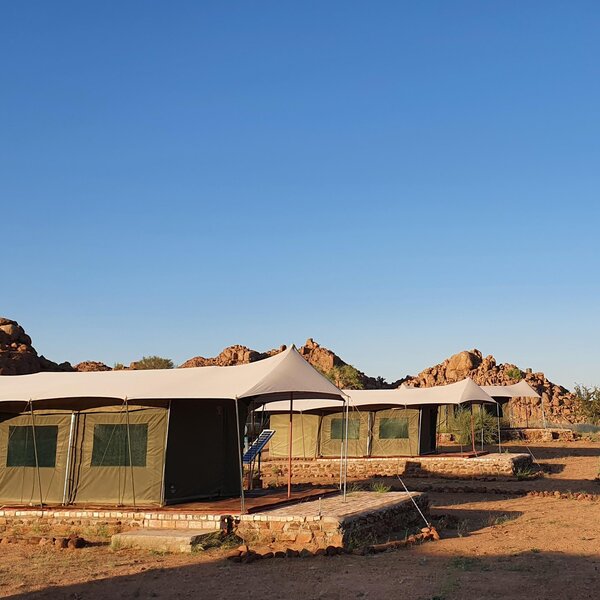
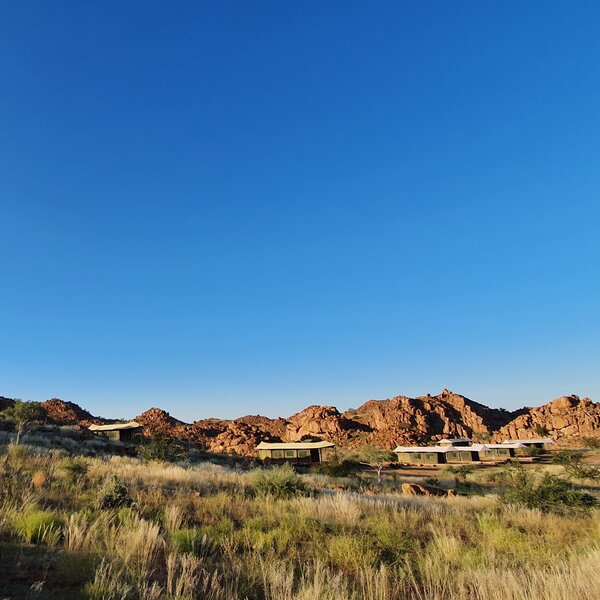
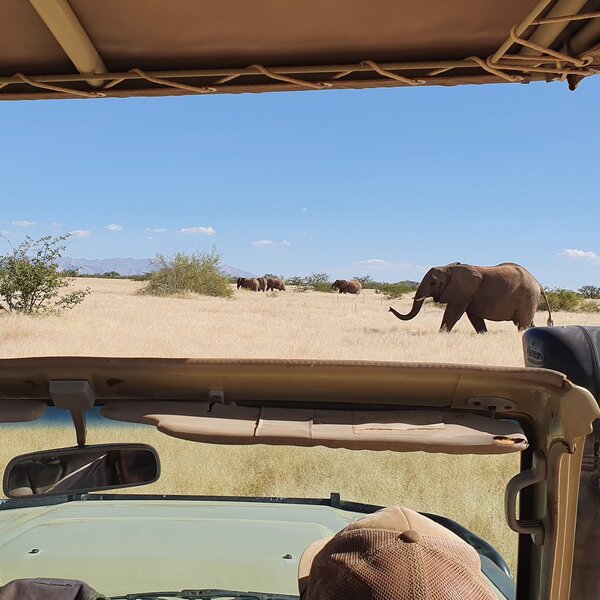

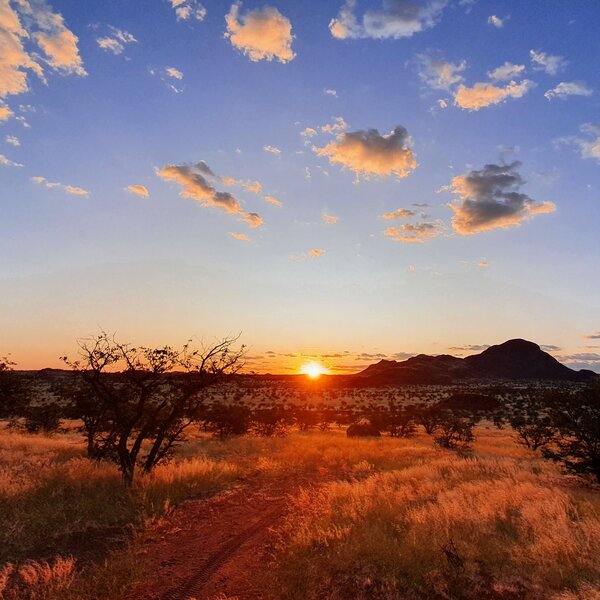
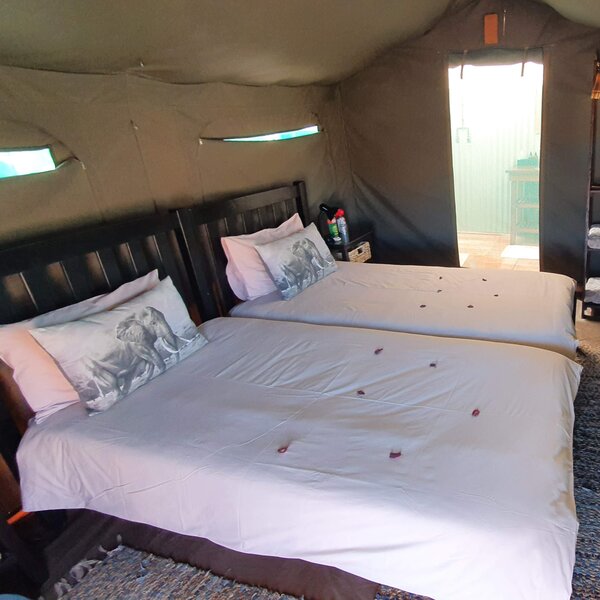
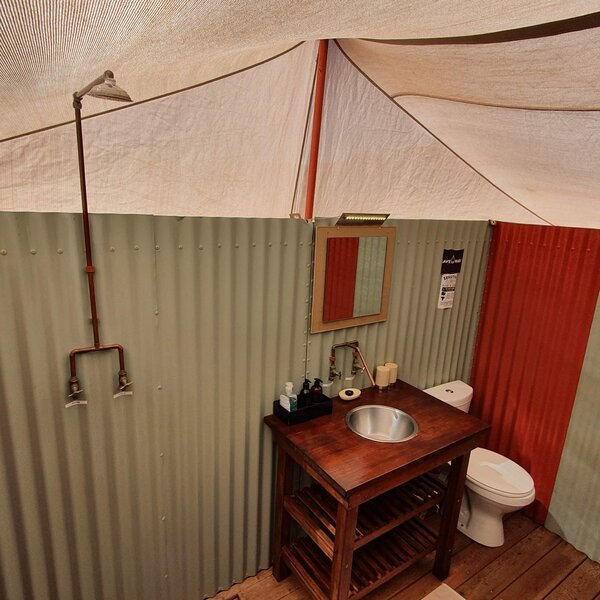
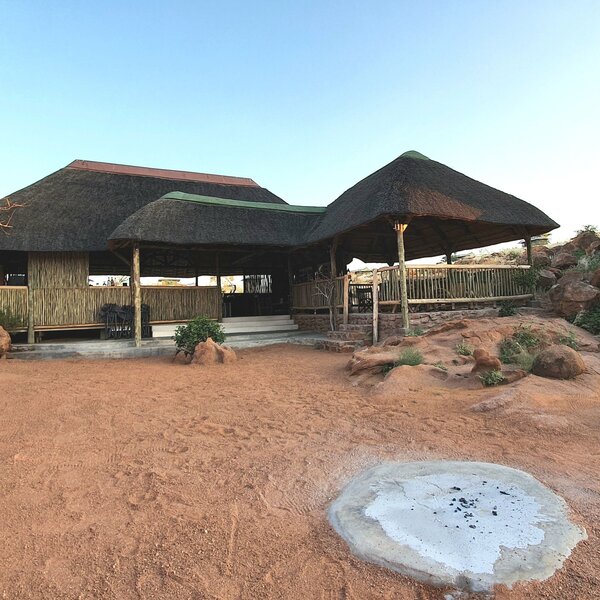
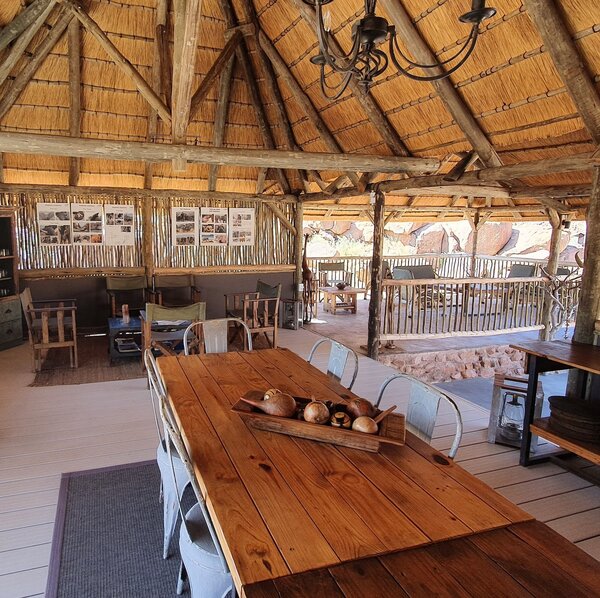
Expert Africa's gallery
When we travel we take lots of photos ourselves to give you a real and un-edited view of the safaris. See our 14 pictures of Ozondjou Trails to get the candid view.
View gallerySafaris visiting Ozondjou Trails
Just ideas, we'll always tailor-make a trip for you
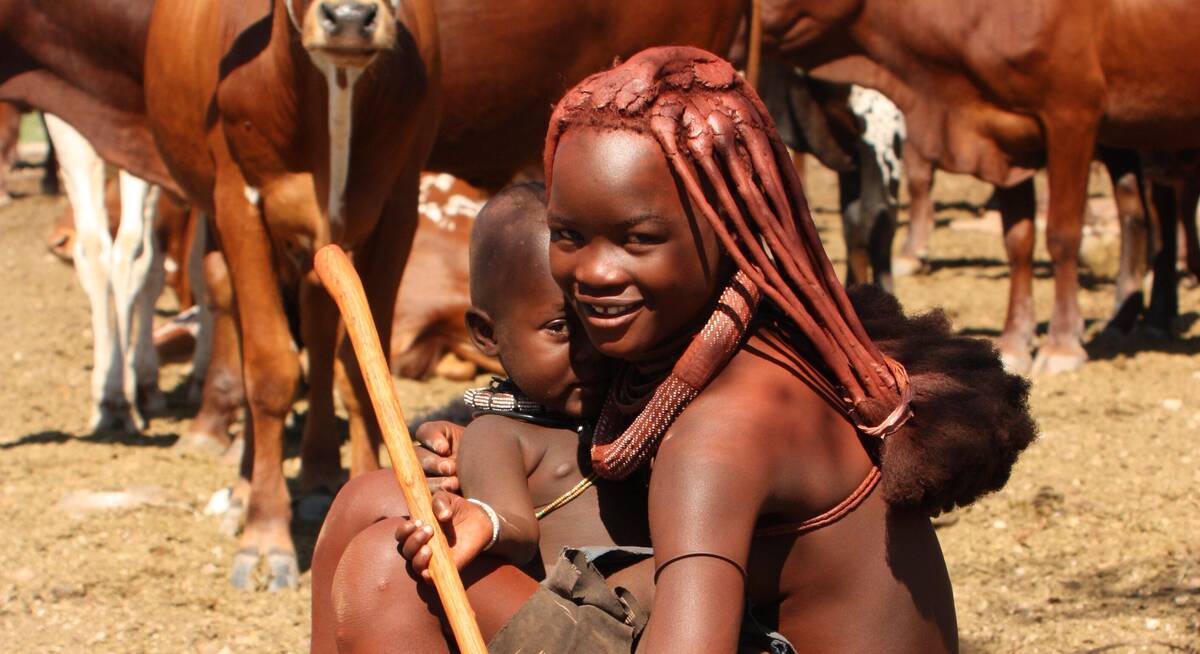
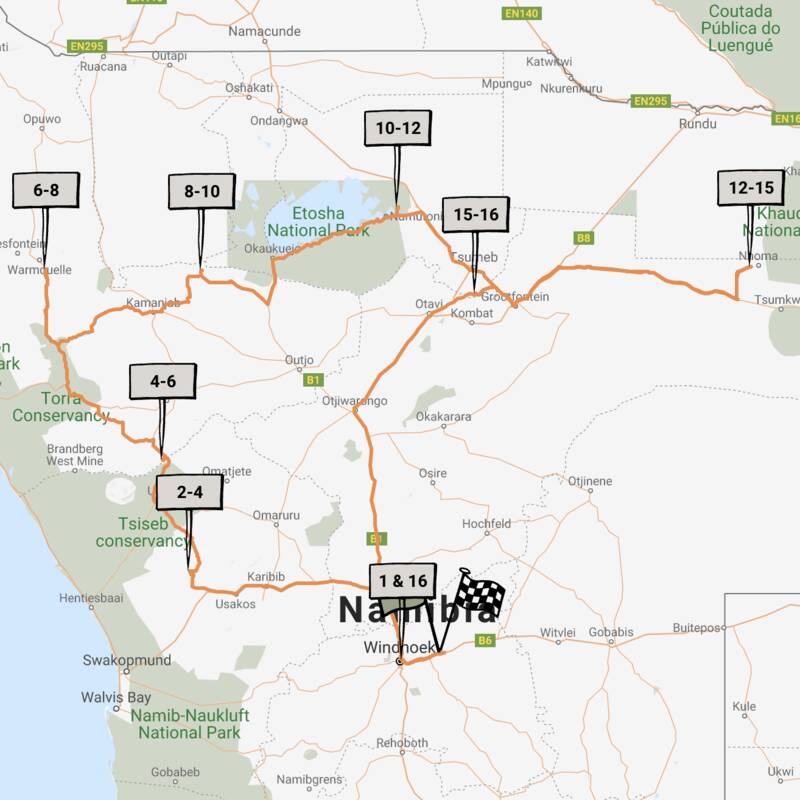
Hartebeest Self-drive Safari
16 days • 8 locations • 1 country
WINDHOEK AIRPORT TO WINDHOEK AIRPORT
This self-drive safari focuses on the best cultural experiences in Namibia. Visit a Himba village and enjoy three days living with the San Bushmen interspersed with some excellent wildlife watching.
Visiting Bushmanland, Central Highlands and 3 other areas
US$4,800 - US$4,980 per person
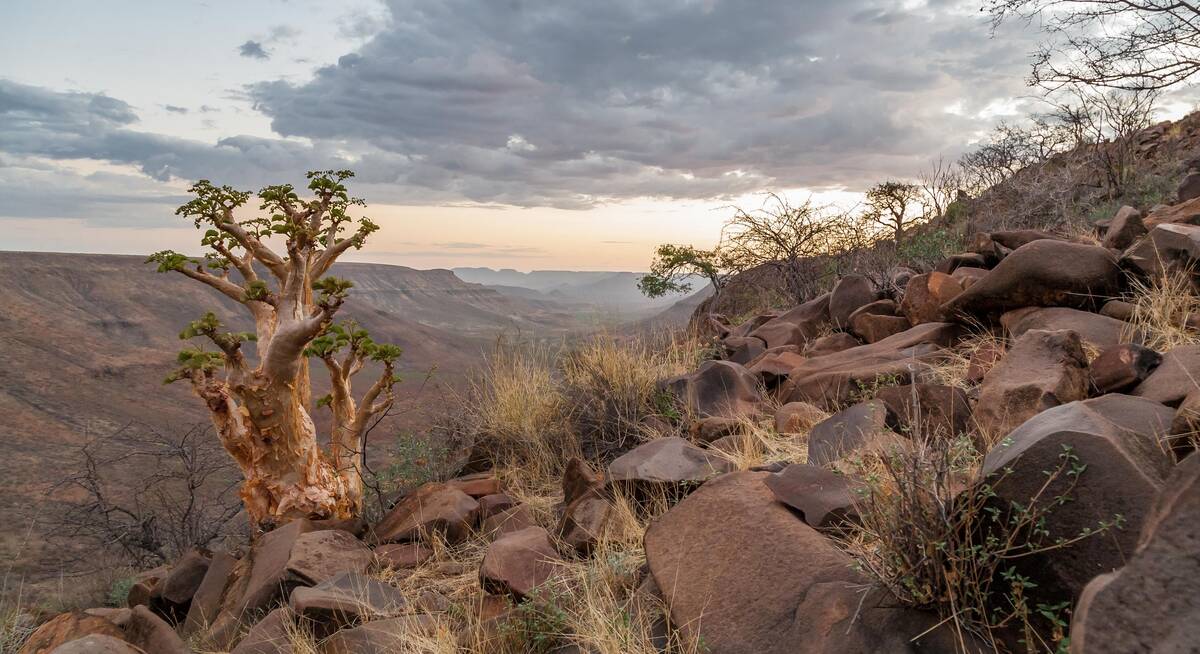
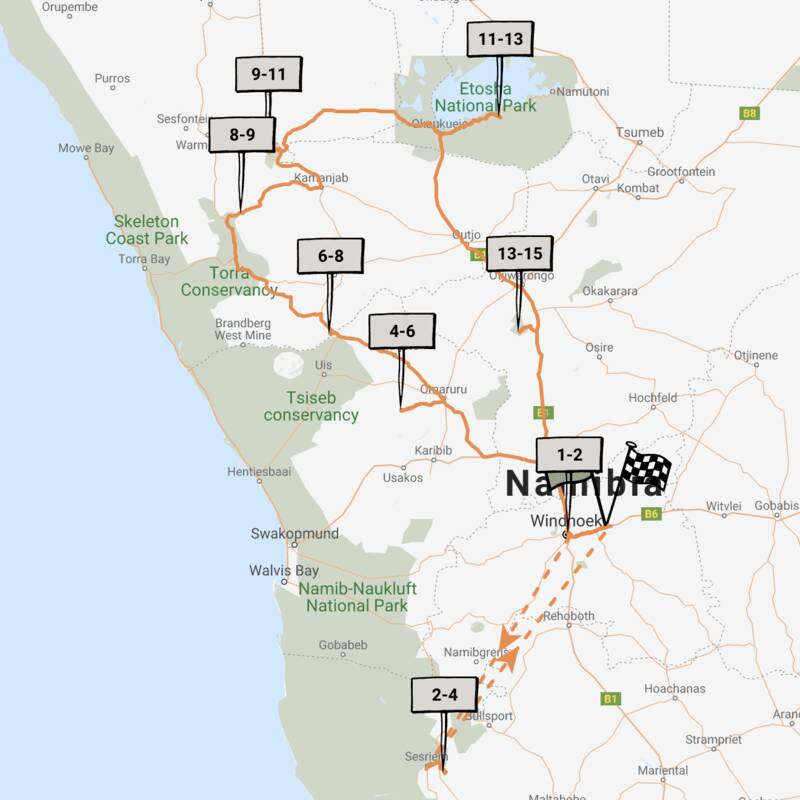
Dune Lark Fly & Drive Safari
14 days • 8 locations • 1 country
WINDHOEK AIRPORT TO WINDHOEK AIRPORT
A combination fly-in self-drive exploration of Namibia, with quick, easy and scenic flights in and out of Sossusvlei before a classic road trip adventure of the country’s rugged north.
Visiting Okonjima, Namib-Naukluft and 4 other areas
US$5,530 - US$5,940 per person
Ozondjou Trails: Our full report
Ozondjou Trails is nestled among the hills of southern Damaraland, not far from the mighty Brandberg Mountain.
Opened in September 2016, it was the first permanent camp from a team with a strong history of running excellent mobile safaris across Namibia. The camp’s name is derived from a Herero word for “elephant”: apt given its proximity to the NGO, Elephant Human Relations Aid (EHRA). Staying here not only affords the opportunity to learn about and see the area’s desert-adapted pachyderms, but also benefits them by supporting EHRA projects including education programmes and efforts to mitigate human–wildlife conflict.
Ozondjou Trails has nine twin tents well-spaced across Damaraland’s undulating terrain. Each Meru-style tent is covered with shade netting to help mitigate the impact of Namibia’s hot sun and is accessed by a small porch with two comfortable camping chairs.
Inside, the bedrooms contain simple furniture including a luggage rack, twin beds and bedside tables with reading lights, mosquito repellent spray and an emergency horn. Large gauze windows can be sealed against the elements with zipped canvas covers, or left open to allow the breeze in, along with the sounds and smells of the bush. As the camp runs on solar power, there are no charging points in the rooms and the lighting is quite dim, so it’s a good idea to take a head torch. There is a charging station in the main area for use during daylight hours.
To the back of each tent, you’ll find an en-suite shower, washbasin and flush toilet. Here, as in the bedroom, space is utilised well, providing travellers with everything they need with little fuss. Do note, however, that the water is heated by solar geyser, so it is not infinite, especially in the early mornings.
During our stay in May 2022, we thoroughly enjoyed the stripped back experience at Ozondjou Trails – you can tell that the team behind the lodge has a history of running mobile safaris. That said, the rooms here are not as luxurious as some of the other options in the wider Damaraland area, and –despite the provision of additional blankets – we couldn’t help feeling that the tents might get rather cold in the winter nights (Jul–Sept). Similarly, even with the shade netting and large windows, we suspect they’ll get rather hot in October–December.
A series of winding, sometimes rough, and occasionally steep dirt paths connect the tents to the main area. Perched on the edge of a gorge overlooking the ephemeral Ugab River, the main structure is a large, open-plan, L-shaped thatched building. Inside you’ll find a big communal dining table, several seating areas, a tea and coffee station and an honesty bar/fridge. Weather permitting, dinner may be served under the stars, which we think would be a magical experience.
Although the structure is mostly open sided, the few walls are adorned with posters produced by EHRA. Some give general information on elephants and their behaviour; others explain how to identify individual elephants and give details on herds you might see.
In front of the main building is a sandy area used for outside dining and braais (BBQs). With a commanding view of the ephemeral river below this is where you’ll also find the camp’s firepit. Here you’ll start the day with an early morning coffee and a rusk, or unwind with a cool drink at the end of a hot day as you keep an eye out for desert wildlife searching for food and water in the riverbed below.
The camp itself is proud of its green credentials: they tell us that it is built in such a way that it could be taken down or relocated at any time with no lasting effect on the environment, and we can believe it. All power is solar generated, and water is provided from a solar-powered borehole.
Ozondjou Trails is usually booked as a two-night package to give guests enough time to experience their range of activities. Most guests arrive mid-to late-afternoon, then – after checking in and orientating themselves – depart on a guided tour. This starts at a local village/farm where the farmer will explain the challenges of living and working in an area with free-roaming wildlife. It then continues to a local school (during term time) before ending with a short walk and sundowners.
The following day you’ll be up early to head out with the EHRA team on a 4WD vehicle as they track and study the area’s desert-adapted elephants. While elephants are the main focus of this trip, travellers may also see plains game such as zebra, kudu, oryx, springbok, ostrich and giraffe. This can be a long day depending on where the herds are, so you’ll usually travel with a packed lunch, returning to camp mid- to late-afternoon. During our visit, we were lucky enough to find a couple of different breeding herds as well as a lone male on musth. Throughout this activity, we were impressed by the passion and knowledge of the EHRA team, who were eager to share their intimate knowledge of the region and its wildlife.
An added bonus is that the area around Ozondjou is relatively quiet, so we’d expect that travellers staying here would usually see fewer vehicles from other camps than in areas further north around Twyfelfontein.
Activities
4WD Safari
Birdwatching
Cultural excursion
Guided walking safari
Private activities
Families & children
- Attitude towards children
- No children under 16 years are allowed in camp, due to free-roaming elephants.
- Property’s age restrictions
- No children under 16 are allowed to stay here.
- Special activities & services
- None
- Equipment
- None
- Generally recommended for children
- We would not generally recommend Ozondjou Trails for families travelling with children. There is no space in the tents for additional beds for under 18s.
- Notes
- Anyone staying at Ozondjou trails needs to be aware of the risk of wild animals in camp.
Food & drink
- Usual board basis
- Full Board & Activities
- Food quality
- Although Ozondjou Trails is a fairly rustic camp, we enjoyed some excellent food during our stay in May 2022. While we were the only guests in camp at the time, we understand that meals are usually enjoyed communally. With advance notice, most dietary requirements can be catered for.
Our breakfast was a buffet of cereals, fruit, juice, tea, coffee and muffins. Hot dishes of bacon, eggs, sausages, tomatoes and omelettes are cooked to order.
During our brief stay, we didn’t have a chance to enjoy lunch at Ozondjou, but we understand that on the day spent tracking elephants with EHRA, guests are usually provided with a packed lunch. We’d expect this to contain a sandwich, fruit, juice, water and perhaps a muffin, or crisps. Packed lunches can also be requested for the day you depart, for an additional charge.
For dinner we enjoyed a four-course meal which started with butternut soup with fresh bread rolls, followed by a Greek-style salad. Our main course was an excellent chicken roulade served with seasonal roast vegetables and mashed potatoes. Finally, the meal was rounded off with a chocolate mousse with passion fruit sauce.
Overall, we were impressed with the innovative and varied options for our dinner, especially as they were produced by a small team in a simple kitchen. - Dining style
- Group Meals
- Dining locations
- Indoor and Outdoor Dining
- Further dining info, including room service
- None
- Drinks included
- House drinks are included.
Our travellers’ wildlife sightings from Ozondjou Trails
Since mid-2018, many of our travellers who stayed at Ozondjou Trails have kindly recorded their wildlife sightings and shared them with us. The results are below. Click an animal to see more, and here to see more on our methodology.

100% success

50% success

50% success

0% success

0% success

0% success

0% success

0% success

0% success

0% success

0% success
Getting there
- Location
- Damaraland, Namibia
- Ideal length of stay
- 2 nights
- Directions
- The camp is situated 4km off the C35 on the road between Uis and Khorixas.
- Accessible by
- Self-drive
Special interests
- Cultural Experiences
- Many travellers visit Damaraland to seek out the area's desert-adapted wildlife. Ozondjou Trails not only offers this opportunity but also gives an insight into the life of modern Namibians and the challenges they face of human–wildlife conflict.
- See ideas for Cultural Experiences in Namibia
Sustainability
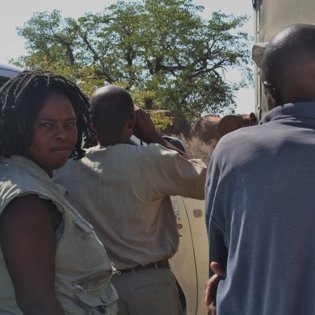
Inciting PEACE at the heart of the Namibian desert
Ozondjou Trails Camp actively supports Elephant Human Relations Aid (EHRA) in their efforts to raise awareness about the conflict between local communities and Namibia's desert-adapted elephants, and their aim to create a more informed and peaceful form of cohabitation.
Although wildlife preservation boosts the revenue generated by tourism, it is difficult to instil this feeling of acceptance among local people who have witnessed elephants compromise their homes and cattle. Profit from projects like Ozondjou Trails sponsor many of EHRA's initiatives such as the PEACE mission (People and Elephants Amicably Co-Existing). This is a two-day seminar created to teach local people how to live without fear of elephants. Funding covers fuel costs for transporting locals to the seminars and those of printing materials such as instructive handouts, a certificate of attendance and brochures for self-drive tourists outlining important information about the region and safety tips to follow if they encounter elephants.
Donations from Ozondjou Trails Camp have also contributed to rebuilding classrooms in local schools, dormitories or building amenities such as toilets, libraries and a computer network with donated computers.
Guests are encouraged to engage in the project. They can join EHRA-trained guides for their daily patrol, searching for desert-adapted elephants and studying their behaviour.
See more great sustainability projects in Namibia
Communications
- Power supply notes
- There are no charging points in the rooms and the 12v lighting is quite dim, so a head torch would be a good idea. There is a charging station in the main area for use during daylight hours.
- Communications
- There is WiFi in the main area of camp but no cellphone signal.
- TV & radio
- None
- Water supply
- Borehole
- Water supply notes
- All bathrooms have plumbed-in basins and showers, with hot and cold running water, and flushing toilets.
Health & safety
- Malarial protection recommended
- Yes
- Medical care
- The nearest hospital is in Khorixas, a drive of approximately 1¼ hours from camp. In an emergency guests can be flown to Windhoek.
- Dangerous animals
- High Risk
- Security measures
- While there is no security on site, the camp staff village is just down the hill in case of an emergency.
- Fire safety
- There are fire extinguishers around camp
Useful info
- Disabled access
- On Request
- Laundry facilities
- There is no laundry service here.
- Money
- Unusually, there are no safes in the rooms at Ozondjou Trails.
- Accepted payment on location
- Any payments for additional activities or packed lunches must be made in cash using Namibian dollars or South African rand only.
Plan and book your trip with Expert Africa
All of our trips are tailor-made, so we'll always adapt them to suit you. Talk to an Expert and let us plan and arrange your perfect trip.

Talk to an Expert
Call or email us now! We’ll match you with the Specialist in our team who is best suited to help you. Then together we can start planning your trip.

Set up your itinerary
Based on our experience and your ideas, your specialist will create a detailed, costed itinerary. We’ll refine it together, until we have a trip that you’re perfectly happy with.

Prepare for your trip
The same Specialist will make the seamless arrangements for your trip, send you detailed travel documents, and be available to answer any questions before you depart.

Travel with peace of mind
After you set off, you’ll be cared for by our partners in Africa, most of whom have worked with Expert Africa for decades. And if you ever need us urgently, we’re available 24/7.

When you return
We love to learn about your trip, and so will always be grateful if you’ve the time to give feedback to your Specialist when you return.
Ozondjou Trails's location
Look closer at the environment and surroundings of Ozondjou Trails.
Other lodges in Damaraland
Alternative places to stay in this same area.
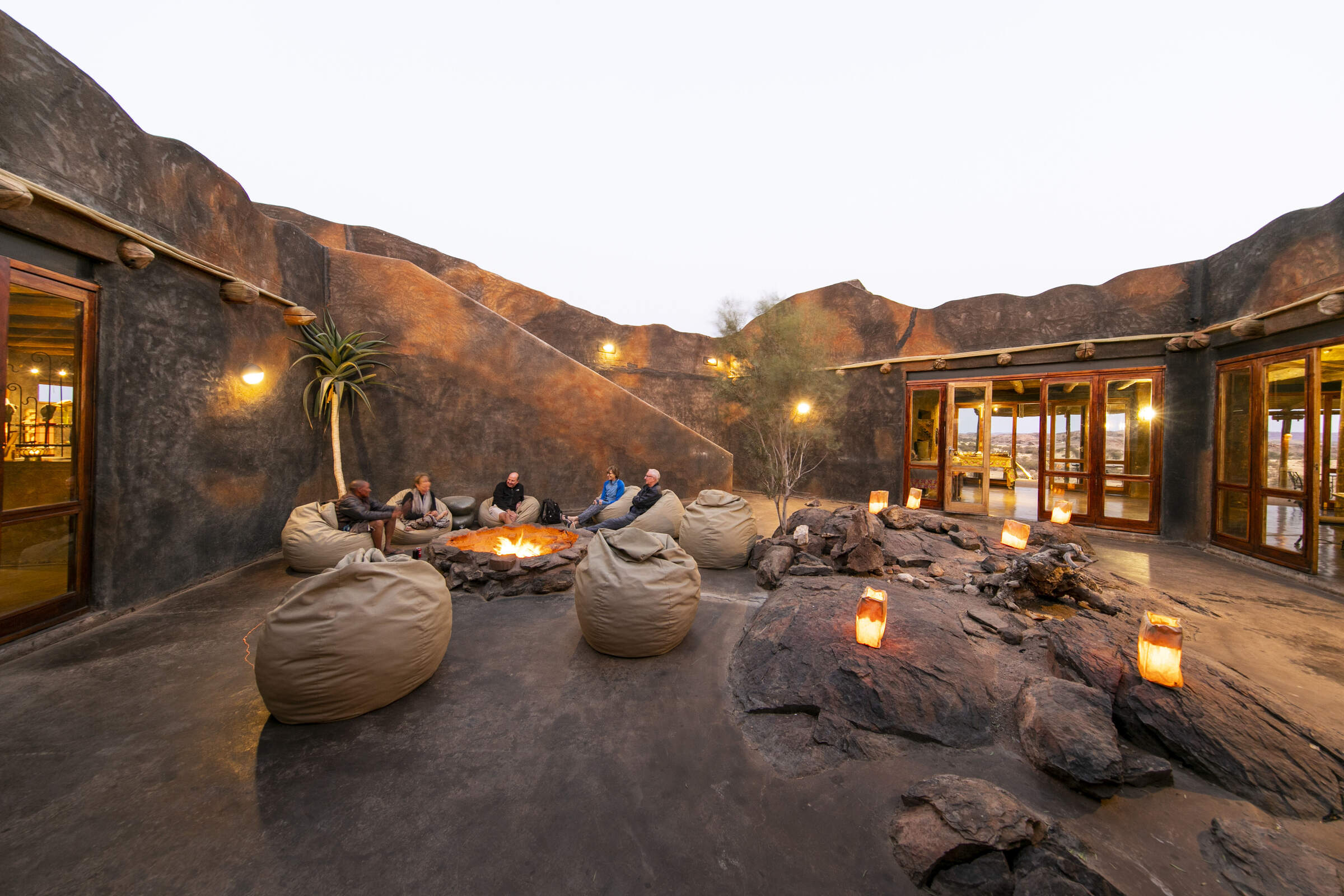
Doro Nawas
Comfortable rooms and a convenient location make the community run Doro Nawas a great base for exploring Damaraland.
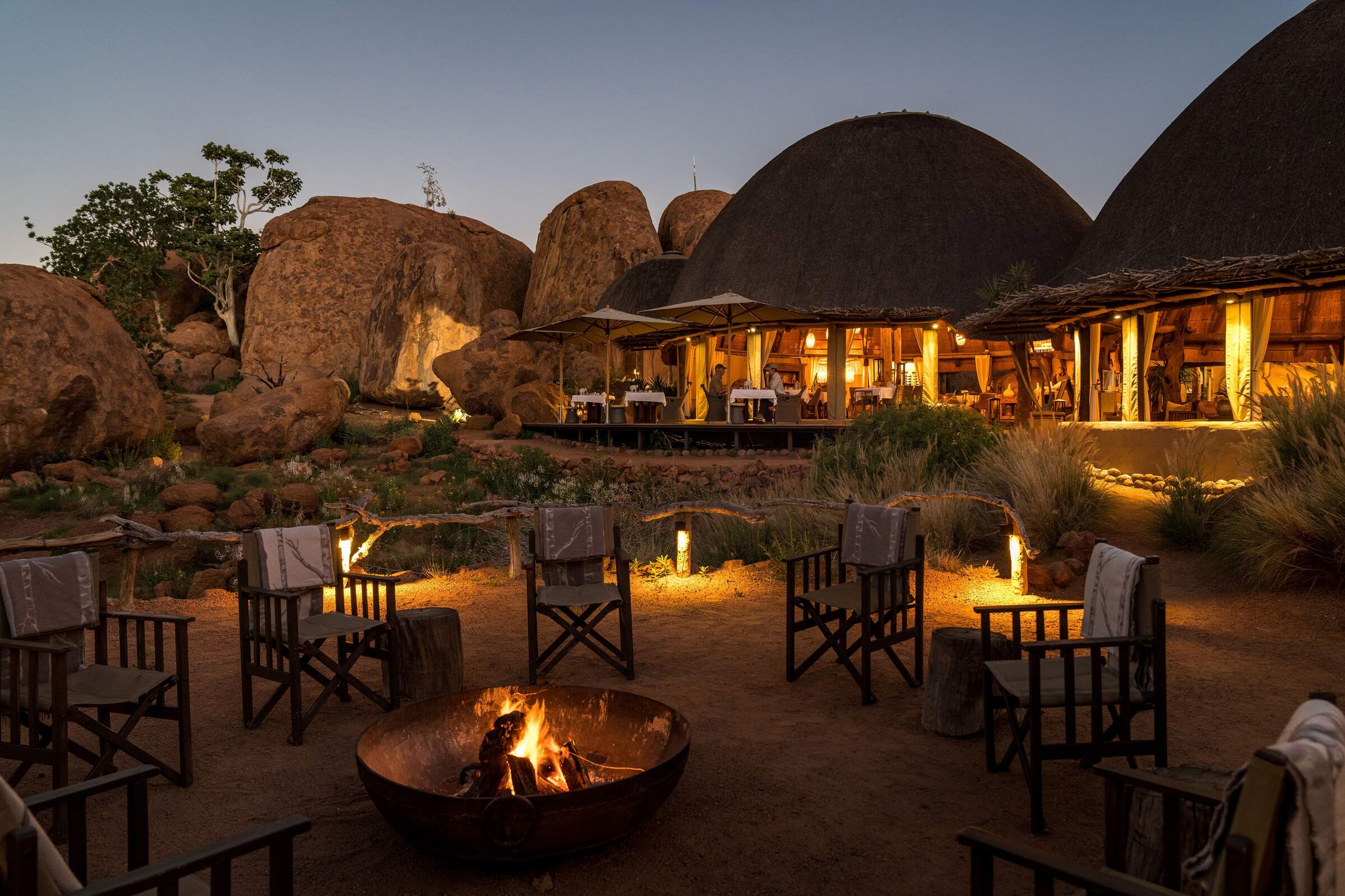
Mowani Mountain Camp
Mowani is a beautiful and stylish mountain retreat in southern Damaraland; it makes a great base for visits toTwyfelfontein.
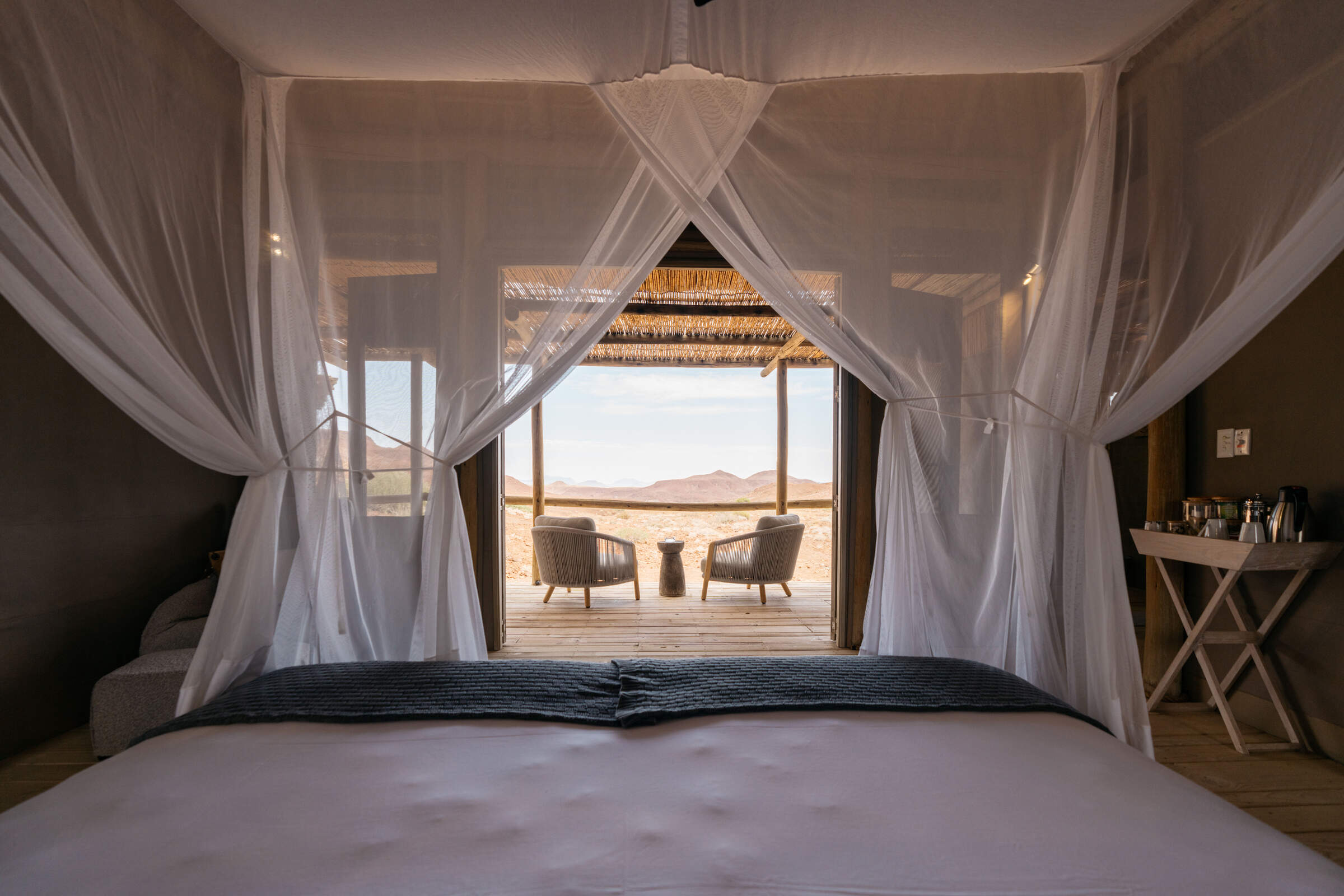
Damaraland Camp
Setting the standard for community partnerships, Damaraland Camp offers a beautiful location, a range of activities – and a genuine welcome.
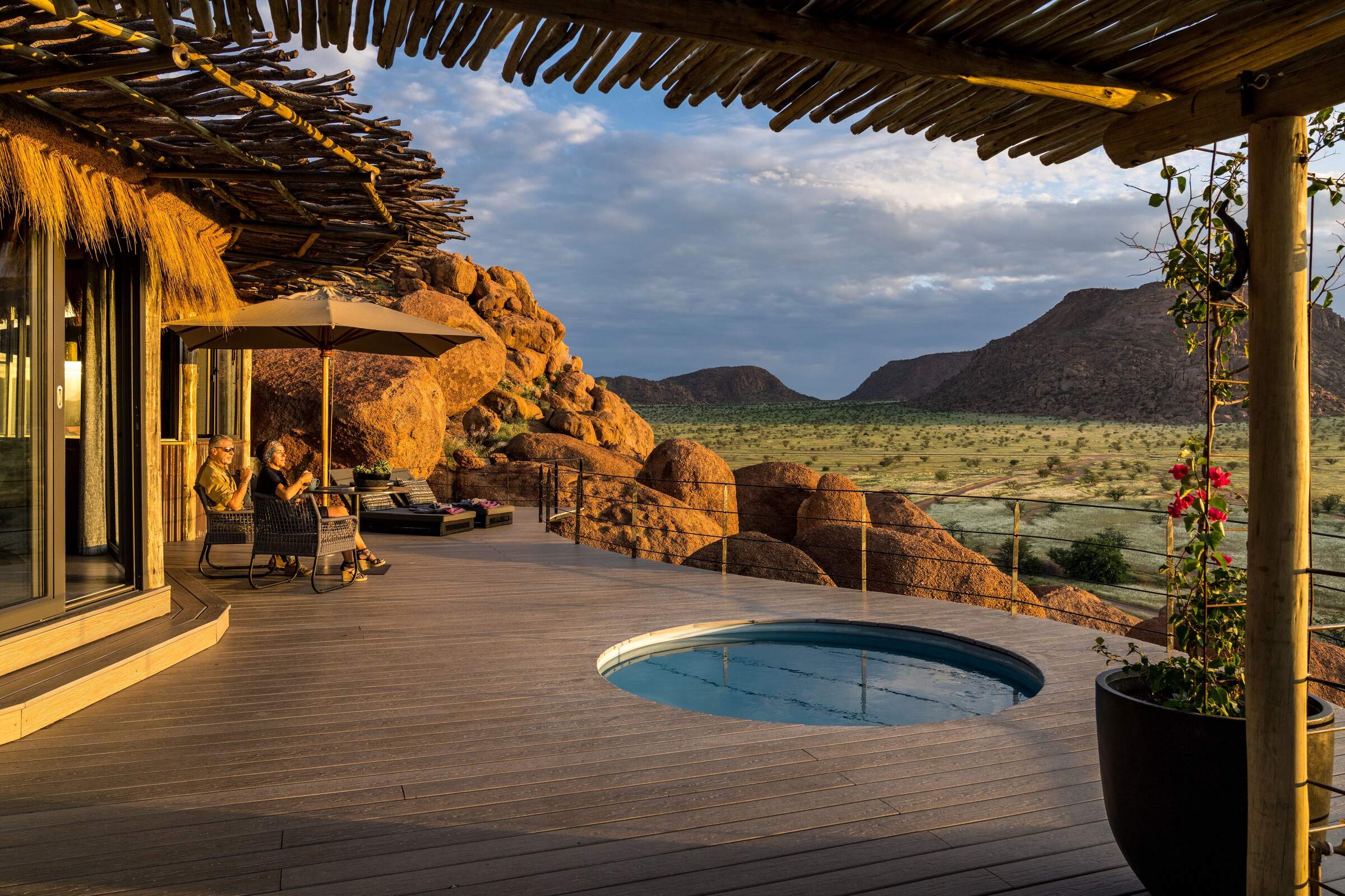
Camp Kipwe
With unusual, igloo-like rooms, open-air bathrooms and beautiful scenery, Camp Kipwe is well placed for nature and cultural excursions.
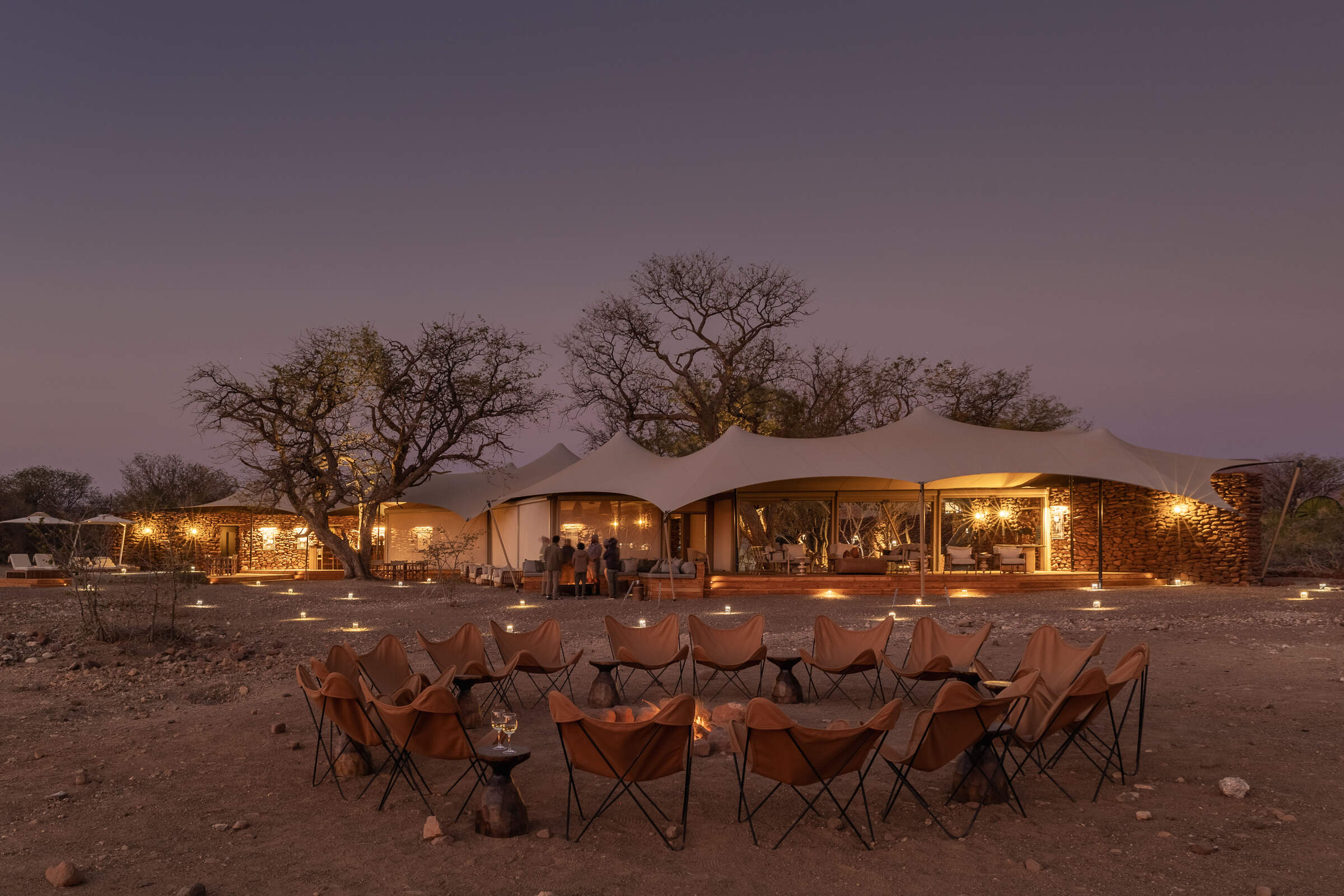
Desert Rhino Camp
Desert Rhino Camp offers a rare opportunity to track black rhino on foot in one of the last true wilderness areas – an amazing experience.
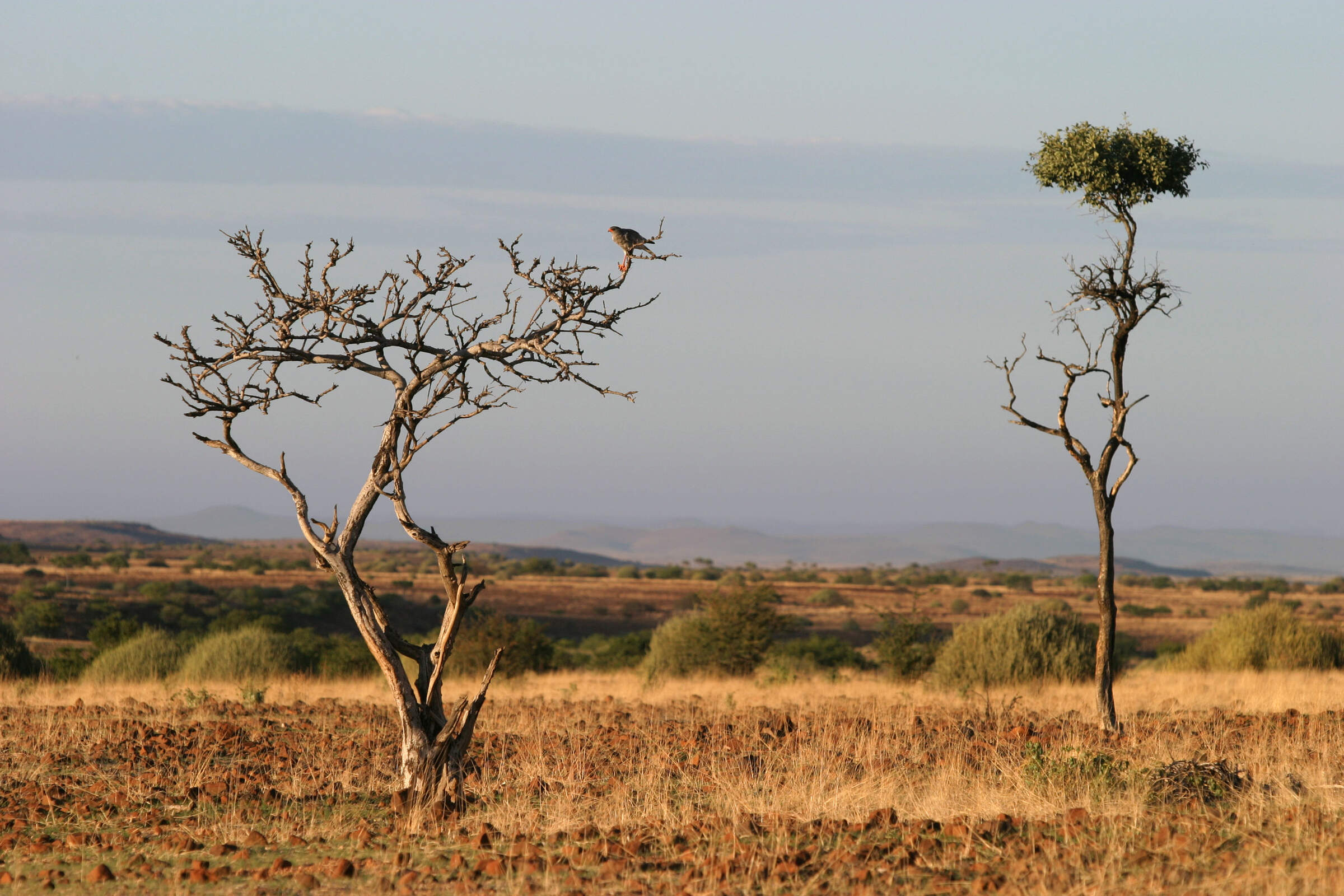
Etendeka Camp
Etendeka is an owner-run camp in the remote and less visited north of Damaraland. The camp is renowned for it's spectacular guided walking trails.
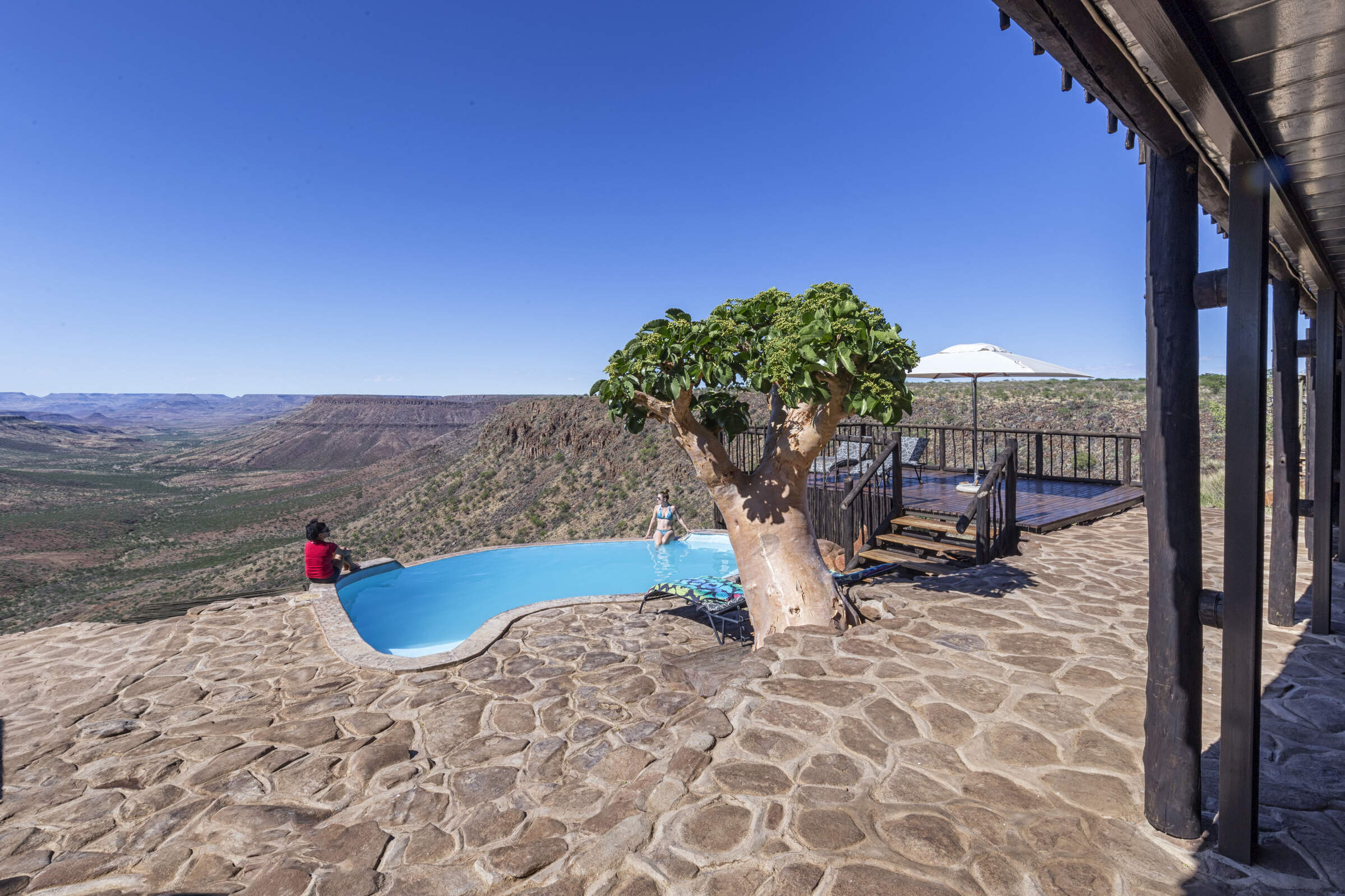
Grootberg Lodge
On the edge of an ancient plateau Grootberg Lodge has a stunning location and arguably the best views of any lodge in Namibia.
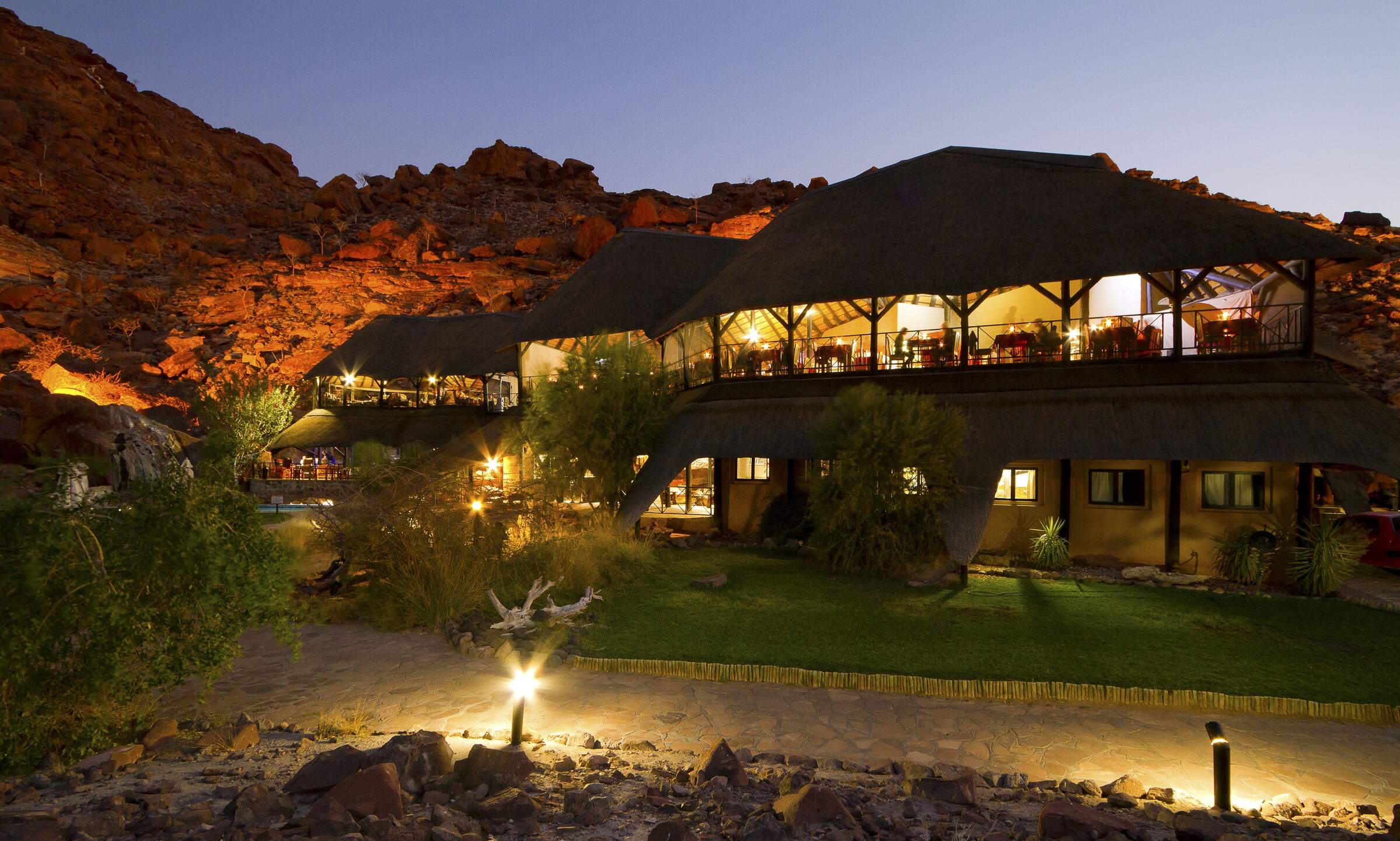
Twyfelfontein C'try Lod.
A large lodge set among the rocks, Twyfelfontein Country Lodge is a convenient base for visiting the rock engravings, which are only 4km away.
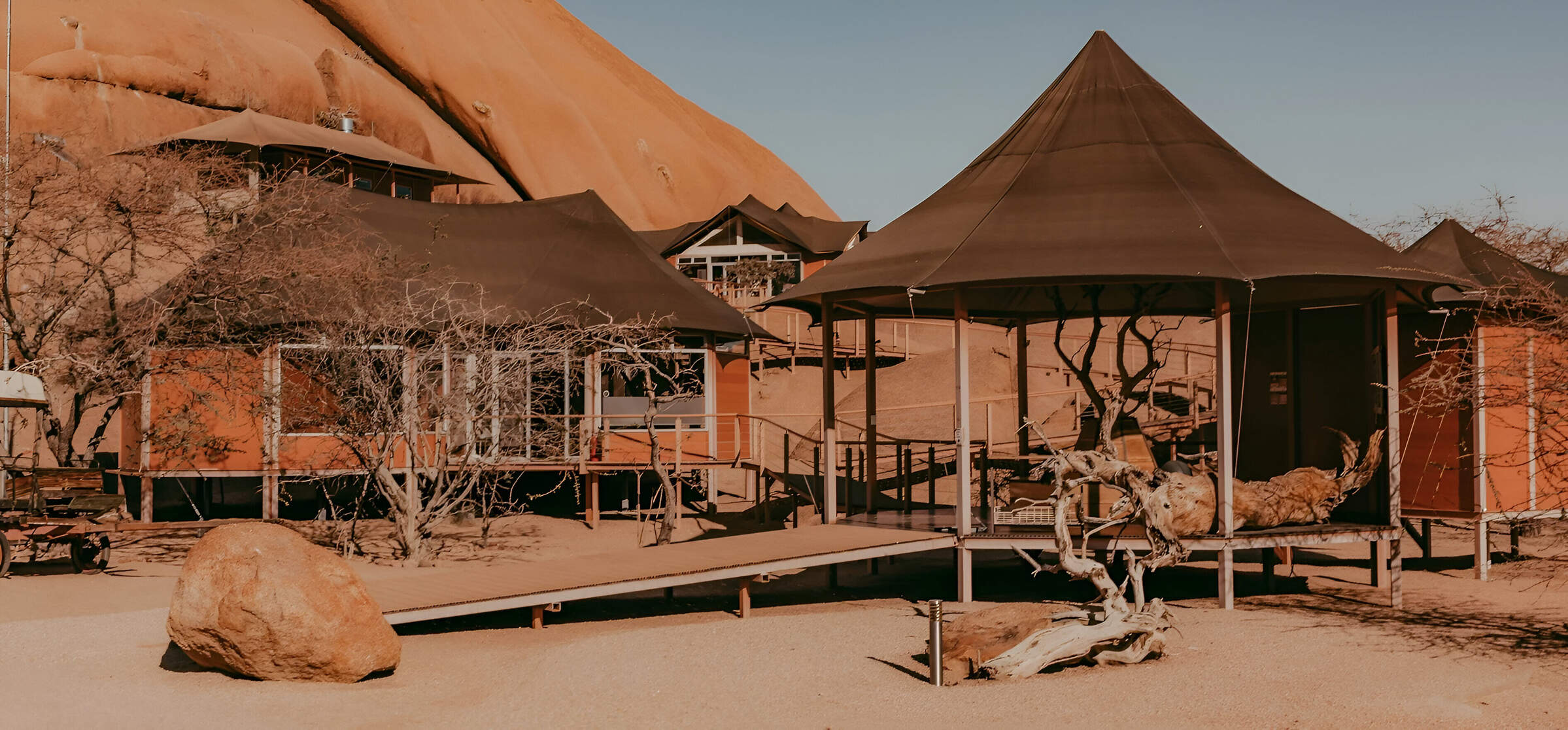
Spitzkoppen Lodge
Spitzkoppen Lodge provides stylish accommodation in an area of scenic grandeur with guided access to sites of ancient Bushman rock art.
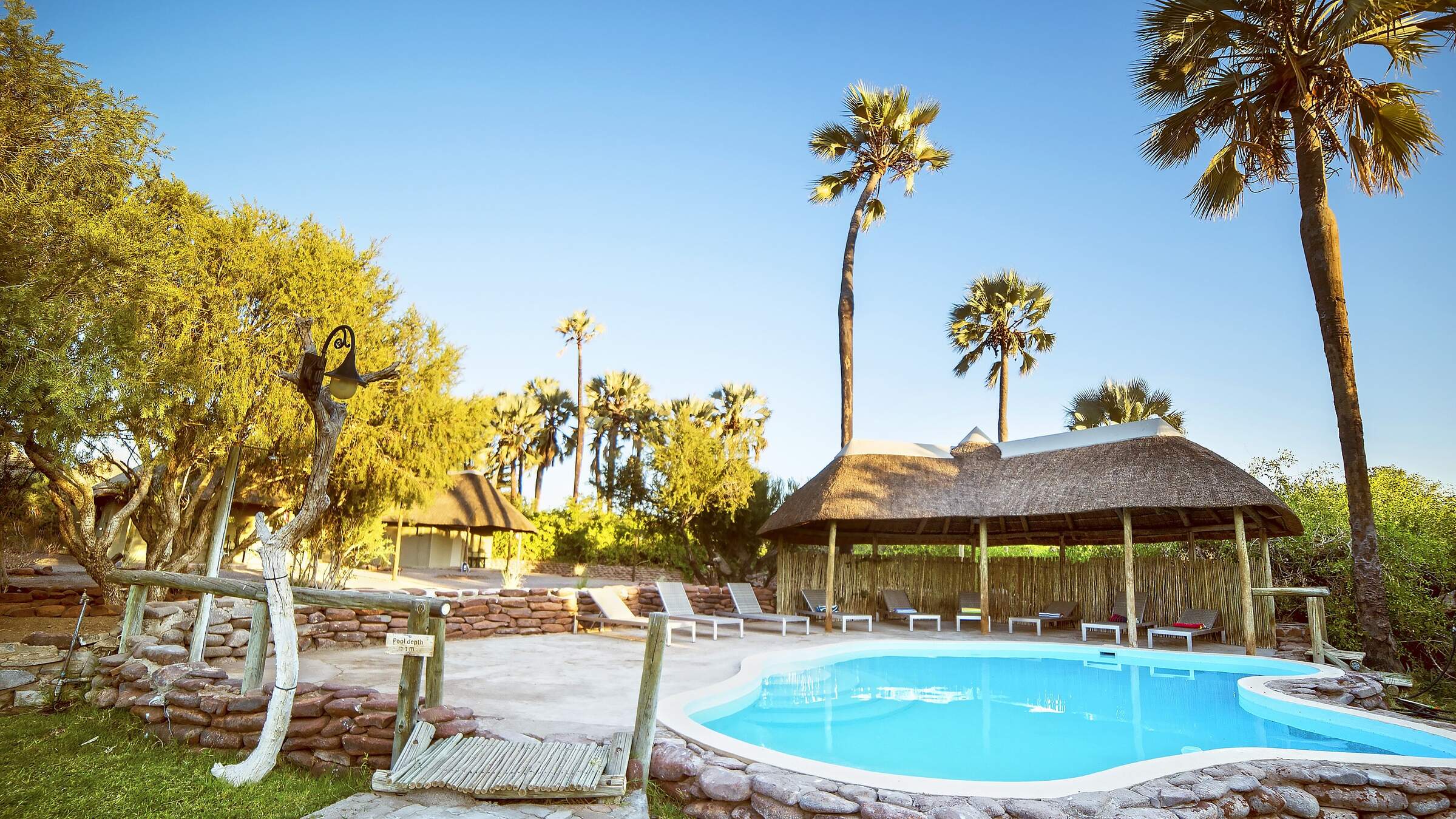
Palmwag Lodge
Palmwag Lodge has a great location by a spring in the Uniab River and offers access to an area where you can see a variety of desert-dwelling animals.
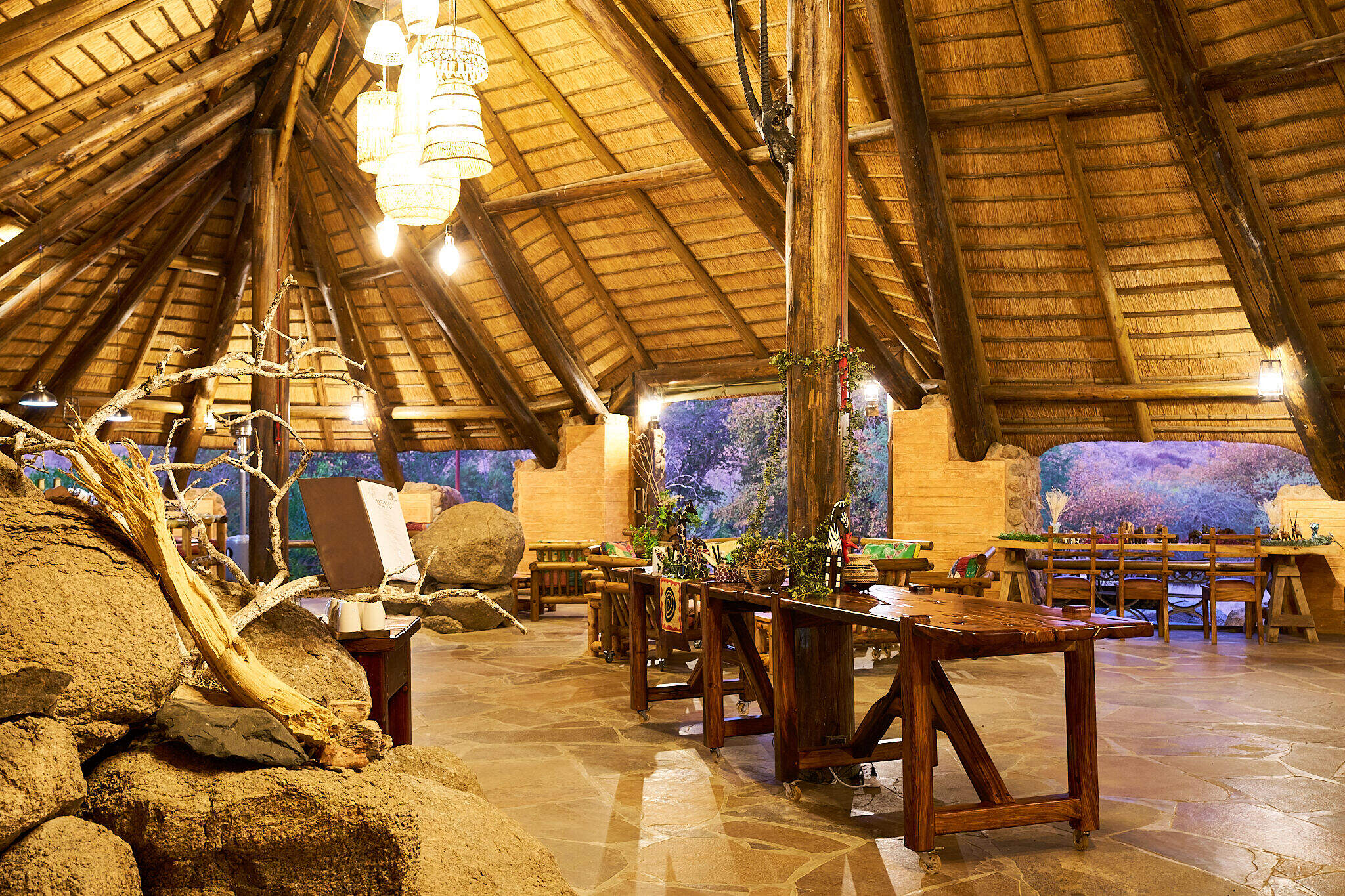
Huab Lodge
Huab is a classic little Namibian Lodge which is slightly off the beaten track in a lesser visited part of Damaraland.
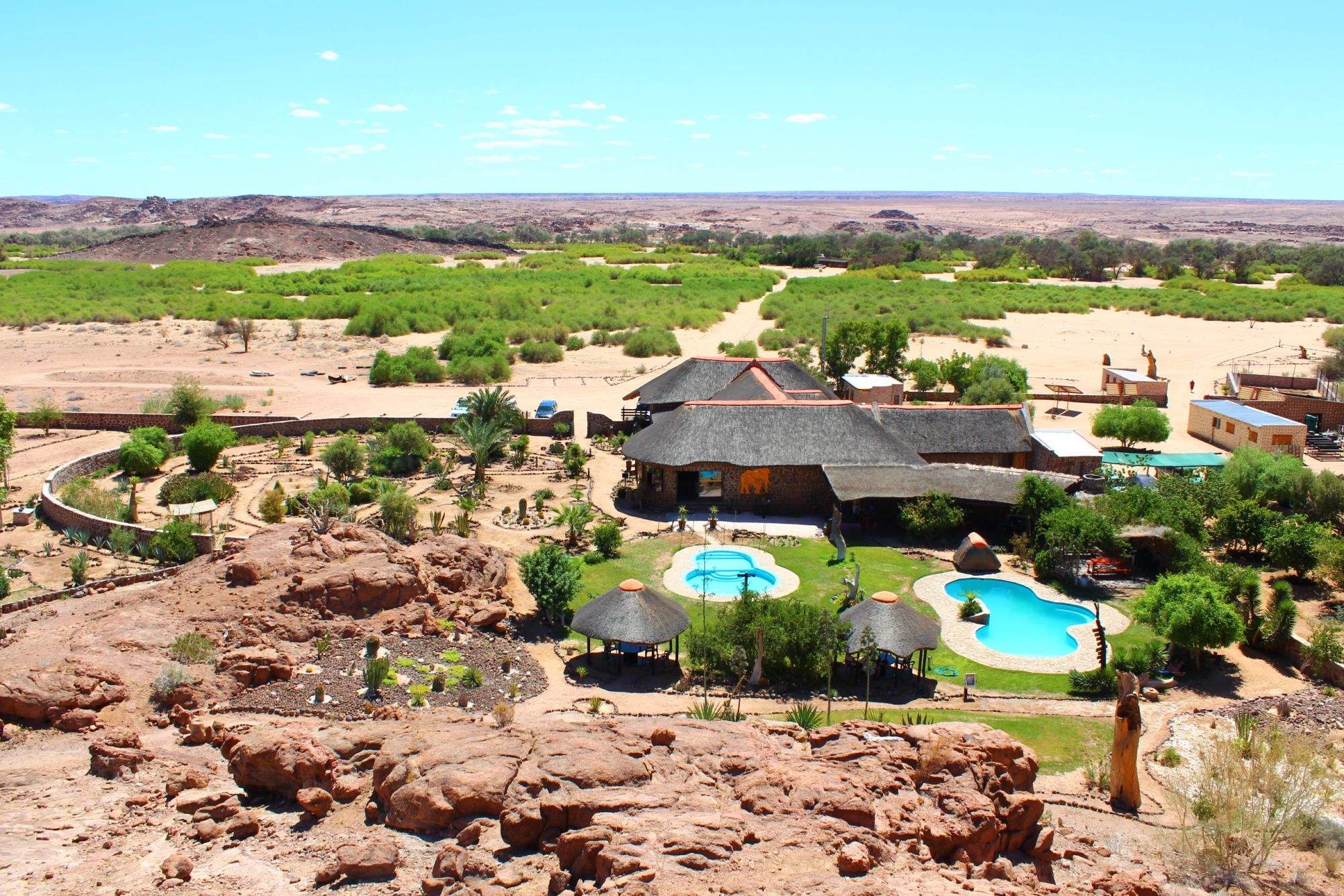
Brandberg White Lady
Brandberg White Lady Lodge, nestled at the foot of its namesake, makes a good base from which to visit bushman rock paintings including the 'White Lady'.
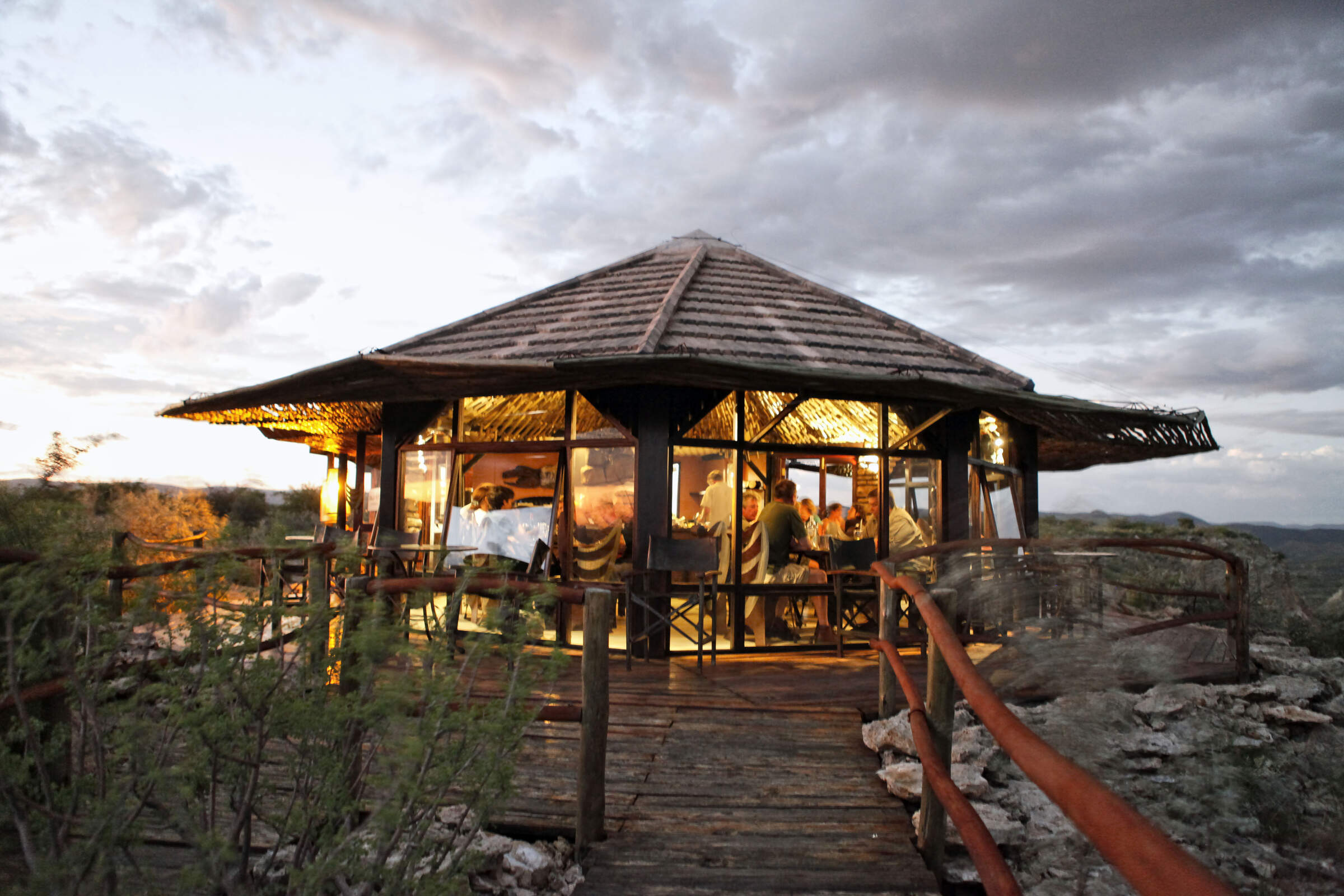
Vingerklip Lodge
Vingerklip Lodge occupies a lovely location, but is a little too far east for guests to visit Damaraland's main attractions.
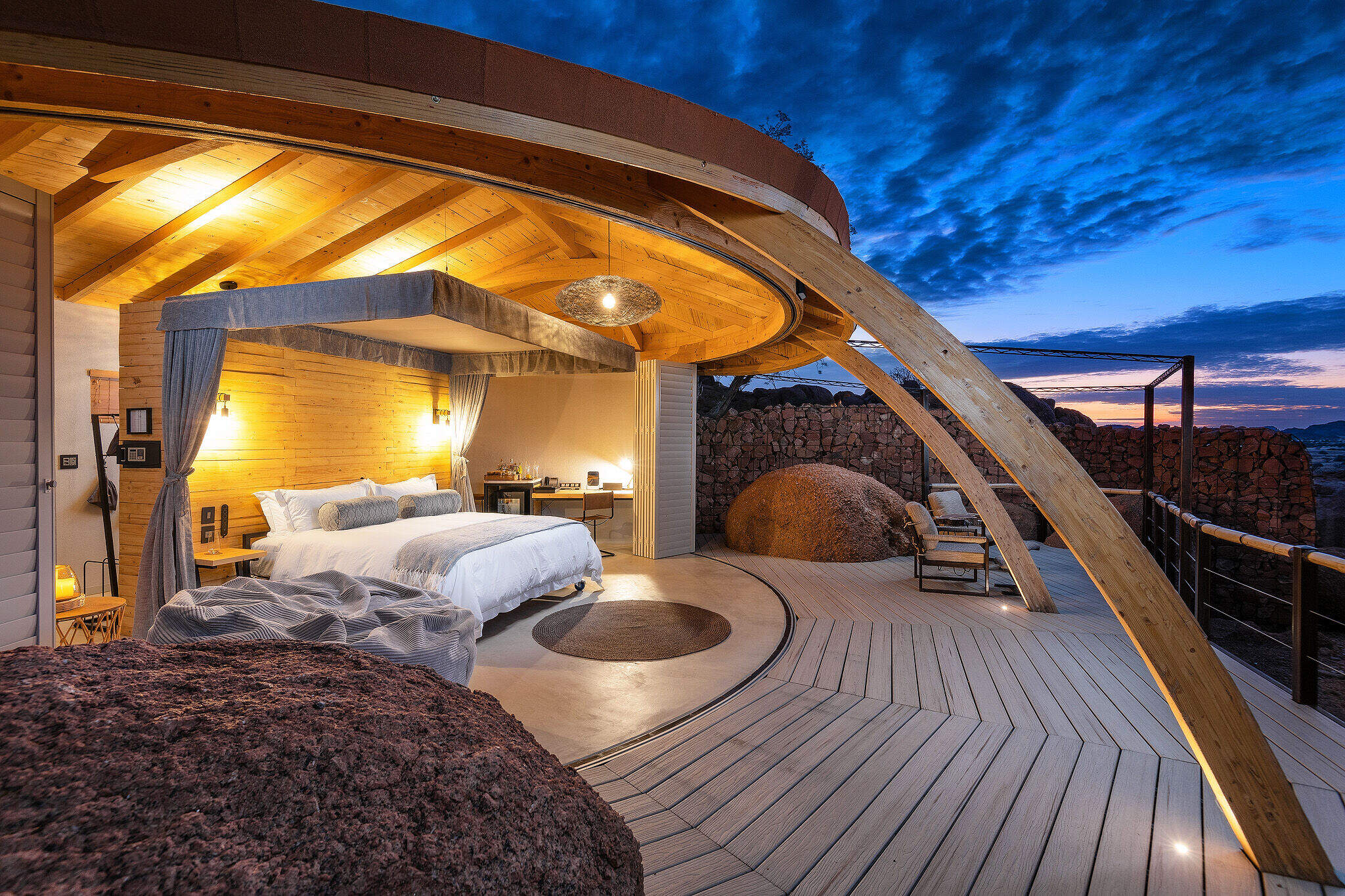
Onduli Ridge
Onduli Ridge is a luxurious, low-impact luxury camp offering top-notch guiding in a remote wilderness area of Damaraland.
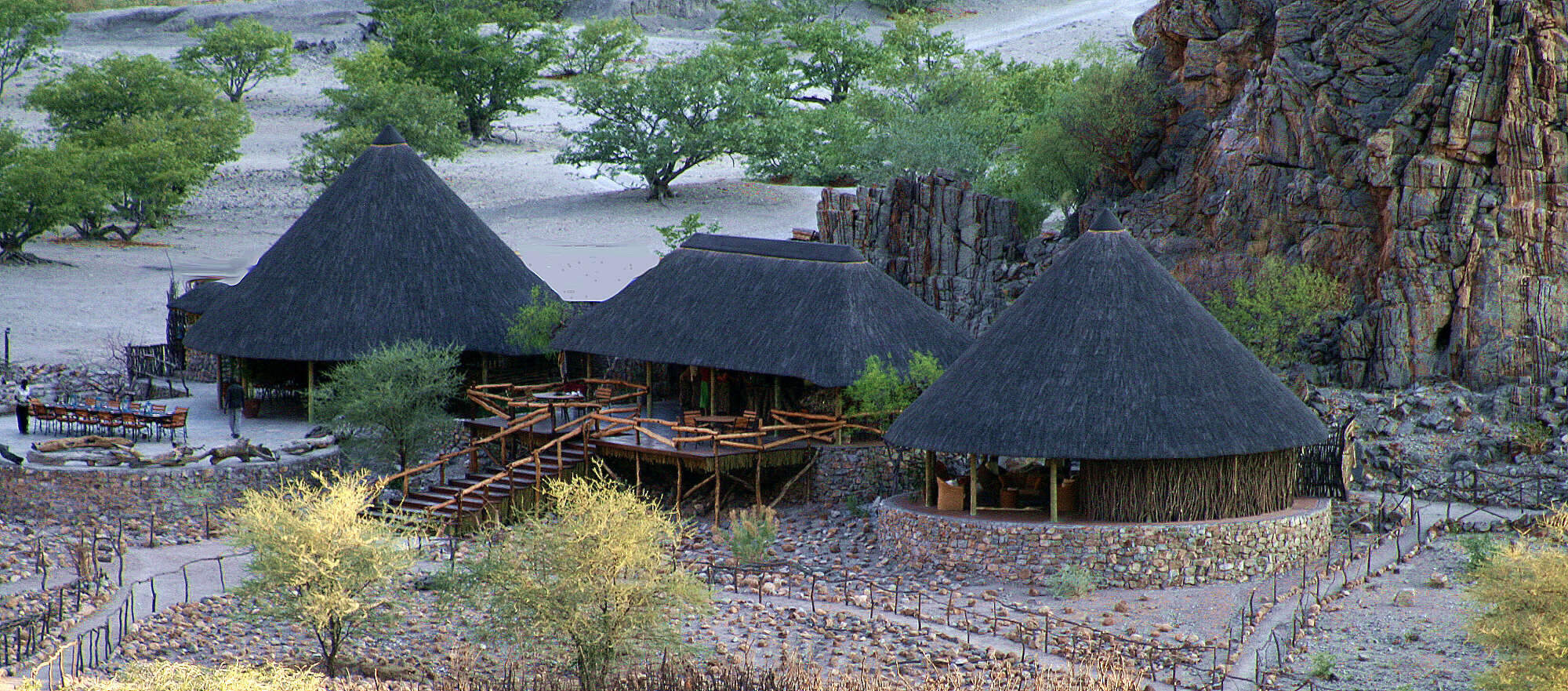
Khowarib Lodge
Khowarib Lodge has a great location overlooking the Hoanib River. This is one of the few places to offer authentic Himba village visits.
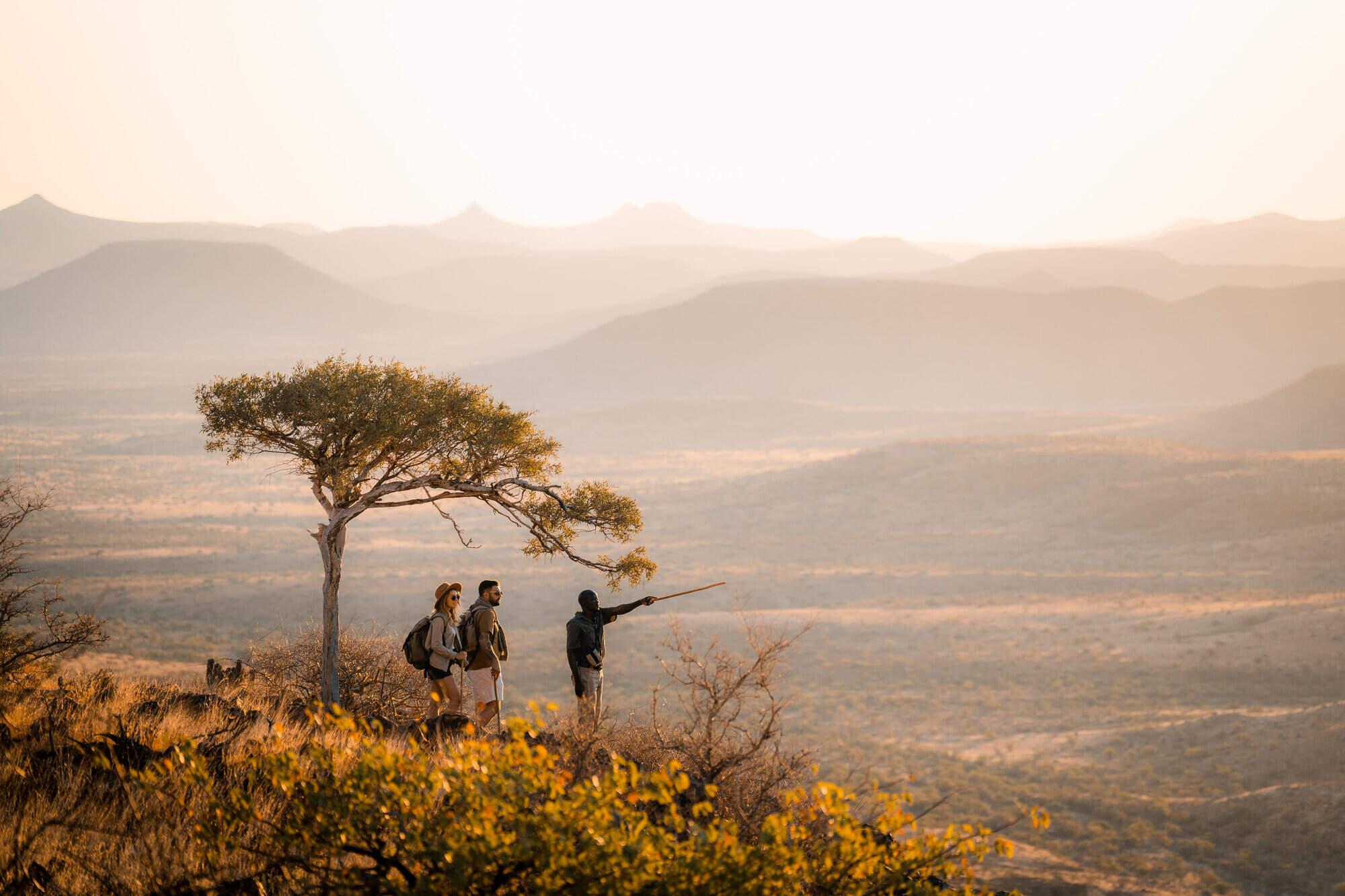
Etendeka Hiking Trail
The Etendeka Walking Trail promises to offer a back-to-basics walking and camping experience in one of Namibia's most remote and untouched wilderness areas.
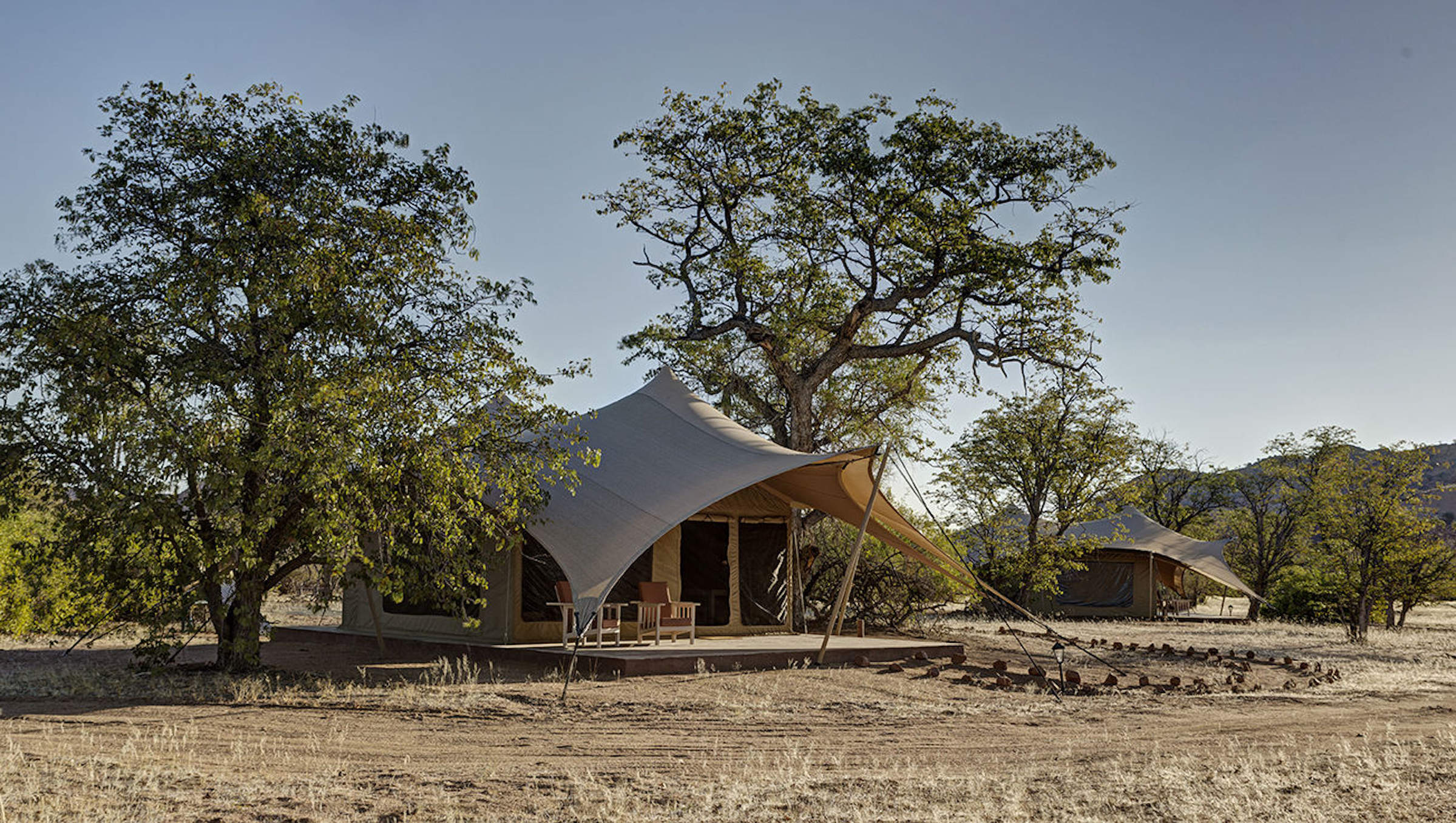
Malansrus Camp
Within easy reach of Twyfelfontein, Malansrus offers a simple but comfortable base for visits to the rock engravings or seek out desert-adapted elephants.
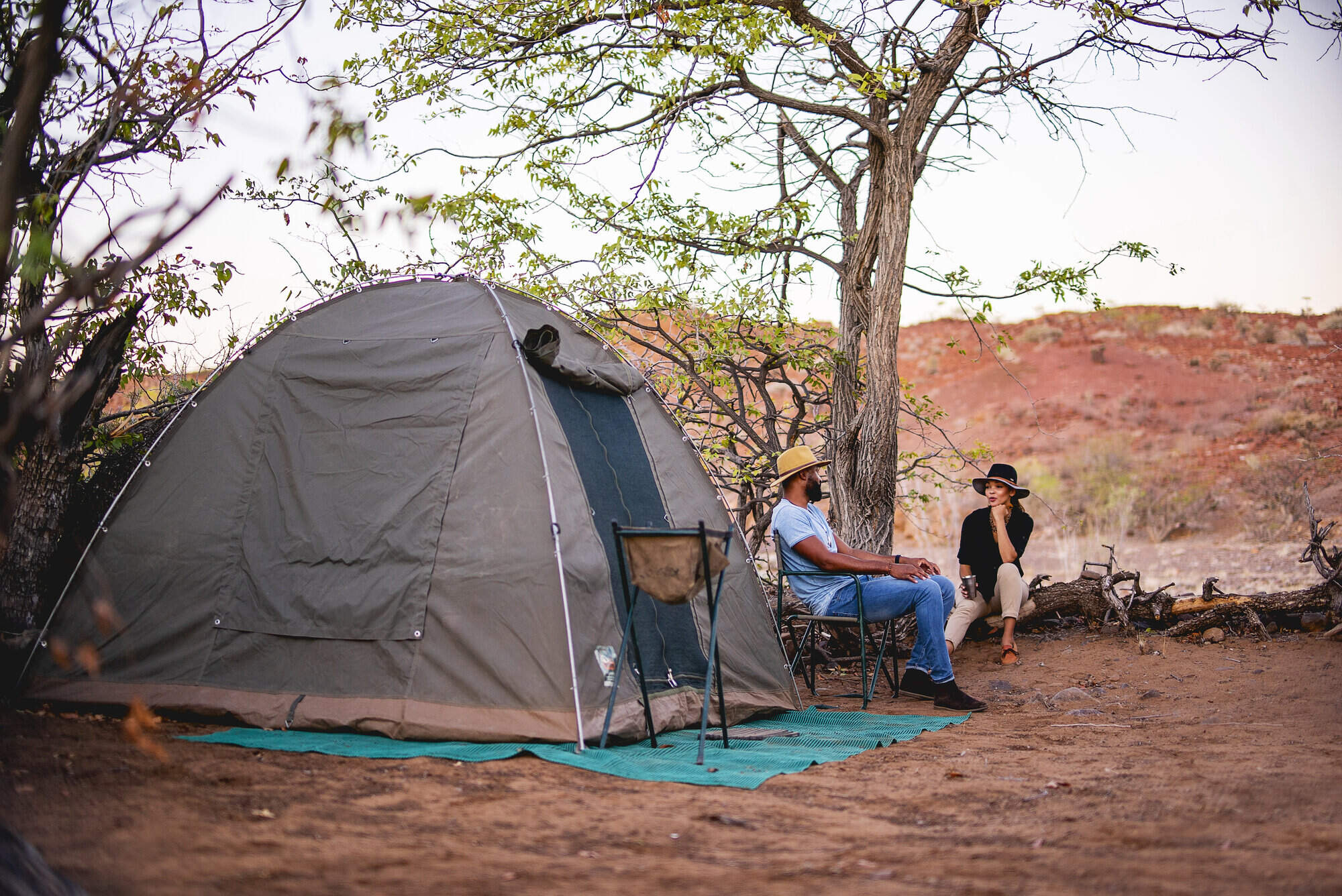
Palmwag Sleep-out
Palmwag Sleep-out is a simple camping experience and a great way to enjoy the remote beauty of the vast Palmwag Concession
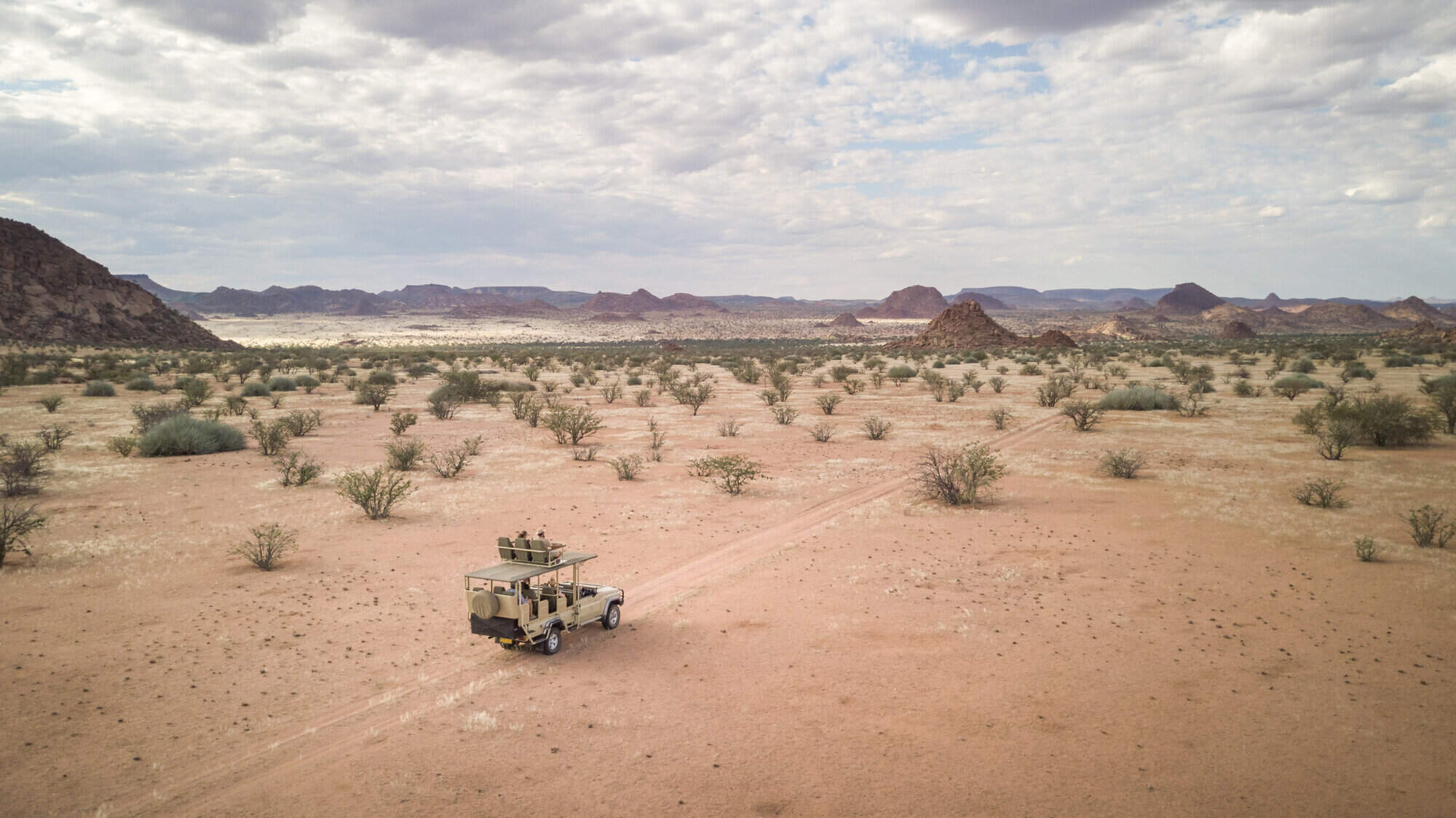
Camp Doros
Small, intimate and with excellent eco-credentials, Camp Doros is set above an ephemeral river within a remote community concession of Damaraland.
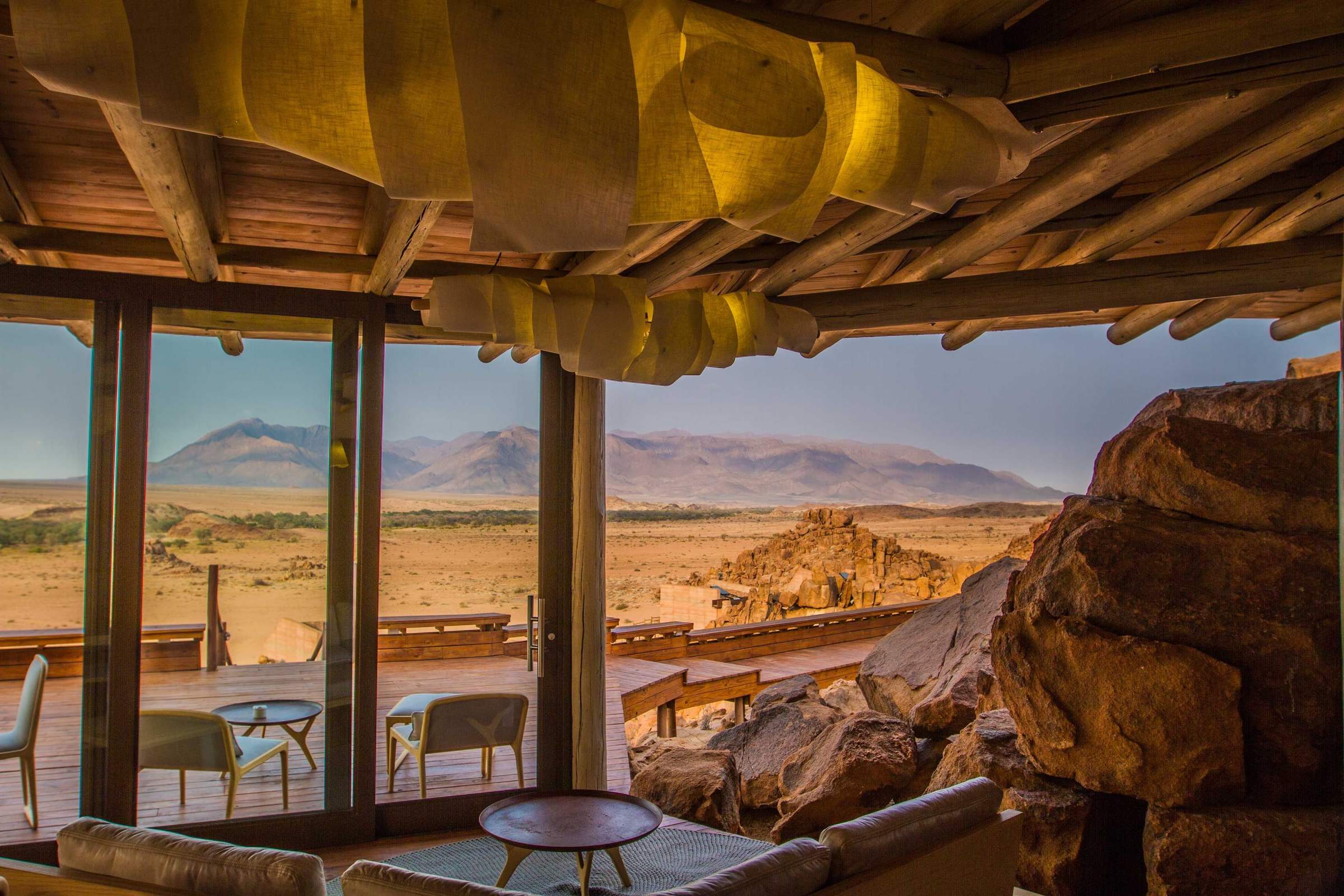
Sorris Sorris Lodge
Overlooking the Brandberg Massif, Sorris Sorris is probably the most luxurious lodge in southern Damaraland.
When to go to Damaraland
Our month by month guide: What it's like to visit Ozondjou Trails in Damaraland
Jan
Feb
Mar
Apr
May
Jun
Jul
Aug
Sep
Oct
Nov
Dec
Damaraland in January
In Damaraland, January marks the start of the rainy season. The rains, though often light and localised, bring life to the desert landscape.
At Twyfelfontein, the rock engravings glisten after sporadic showers. Some days are clear and hot, with temperatures around 30°C/86°F, while others see dramatic thunderstorms. These can create flash floods in ephemeral riverbeds like the Ugab, temporarily transforming the arid terrain. The greening landscape provides a refreshing backdrop for the ancient rock art at Brandberg Mountain.
Many birds in the region are in full breeding plumage, with migrant species adding to the variety. Wildlife, including the desert-adapted elephants, disperses across the rejuvenated landscape, making sightings more challenging, but rewarding. The Damara Living Museum offers insights into how local communities adapt to these seasonal changes.
- Variable weather: hot, dry or humid with rain
- Occasional localised thunderstorms
- Wildlife dispersed, harder to spot
- Stark mountains against atmospheric skies
- Few tourists, low rates at accommodations
Our view
This is not a great time to visit
Weather in January
Damaraland in February
February is typically the wettest month in Damaraland, though rainfall remains patchy across this predominantly arid region.
The Spitzkoppe granite peaks against thunderous, atmospheric skies create dramatic vistas for photographers. Some days are clear and hot, while others see afternoon thunderstorms that briefly but dramatically charge the landscape. These rains can make travel more challenging, especially to remote sites like the Epupa Falls. However, the landscape feels vibrant and alive, with insects and smaller animals more easily spotted, and seasonal flowers blooming. Many birds and animals are raising their young, offering unique wildlife viewing opportunities.
Despite the rains, the rock art at Twyfelfontein and the Petrified Forest remain accessible.
- Hot and humid with occasional rain showers
- Thunderstorms meander over the landscape
- Birdlife spectacular, migrant species present
- Wildlife harder to see, but landscape lush
- Low tourist numbers, great for solitude
Our view
This is not a great time to visit
Weather in February
Damaraland in March
March in Damaraland usually sees the main rains tailing off, though precipitation varies greatly across the region. Many days are clear, with strong sun driving temperatures up, while others may experience light rainfall.
The landscape often appears vivid and green, providing a striking contrast to the bare rocky outcrops of Spitzkoppe and Brandberg. Animals such as springbok and mountain zebra may be finishing raising their young. Small herds of plains game such as these can be more visible against the greener backdrop. The Damara Living Museum showcases how local communities adapt to these seasonal changes. The clearer skies towards the end of the month make for excellent stargazing at lodges where you can move your bed to sleep under the stars.
- Weather becoming drier as month progresses
- Animals looking healthy after months of plenty
- Balmy nights sleeping under star-filled skies
- Migrant birds begin to depart
- Few tourists, rates often low at lodges
Our view
A good time to visit, with pros & cons
Weather in March
Damaraland in April
April in Damaraland is typically dominated by dry weather, with decreasing chances of rain. Temperatures begin to fall, but days remain pleasantly warm. The rains often leave the landscape verdant, creating stunning photo opportunities at sites like the Etendeka Plateau and Klip Valley.
Animals are in fantastic condition, often with fast-growing young in attendance. The desert-adapted elephants may be more easily spotted as they begin to return to the riverbeds to feed on Ana and Camelthorn trees. With dust washed from the atmosphere, photographers can capture clear shots of spectacular landscapes. Stargazers will enjoy increasingly clear night skies. In the Palmwag Concession, water and food remain in plentiful supply, so finding mammals such as black rhino can still be challenging, but worth the effort.
- Cooler nights, days still warm and pleasant
- Landscape still green from recent rains
- Air clear, for crisp photographs
- Wildlife starting to become easier to find
- Easter sees an increase in visitors
Our view
A good time to visit, with pros & cons
Weather in April
Damaraland in May
By May, Damaraland is usually drying out fast. If rains have been good, the land remains green, especially around natural springs found in valleys and craggy rocksides. The air quality and clarity can be amazing, making this an ideal month for photography at sites like Twyfelfontein and along the remote Hoanib riverbed.
Temperatures are moderate, typically warm with crisp, clear mornings and blue skies. Evenings are cool enough to wear an extra layer. Many lodges still charge low season prices, offering good value. The combination of increasingly good wildlife sightings, beautiful landscapes, and crystal-clear air make May one of the best months to visit Damaraland. It's an excellent time to explore the region's geological wonders, such as the ancient Etendeka lava flows.
- Lovely weather: warm days, cool nights
- Landscape drying out, still some greenery
- Clear, sharp colours for photography
- Wildlife more visible along scenic riverbeds
- Low visitor numbers, moderate lodge rates
Our view
A very good time to visit
Weather in May
Damaraland in June
June sees Damaraland dry and clear, with blue, largely cloudless skies. Days are often lovely and warm, but nights can be cold, sometimes below freezing in desert areas.
Visitors should pack warm clothing for early morning nature drives to spot desert-adapted elephants or black rhinos. Most outdoor pools are too cold for swimming, except for the very dedicated. It’s a particularly good climate for walking; either short walks or perhaps a multi-day hike on the Etendeka Plateau.
Historically, June prices have been low, but Damaraland's increasing popularity means many lodges now consider it high season.
- Clear, bright days and cold nights
- Wonderful for stargazing and night walks
- Good wildlife viewing in remote wildernesses
- Hiking comfortable in cooler temperatures
- Moderate lodge rates, increasing bookings
Our view
A very good time to visit
Weather in June
Damaraland in July
July in Damaraland offers fairly warm temperatures above 20°C/68°F in the middle of the day, but often cold nights. Visitors should dress in layers and be prepared for chilly mornings and evenings.
Rain is extremely rare, and clear skies make for great photographs of the sandstone mountains in morning and evening light. As vegetation shrivels, animals gather near food and water sources, making sightings of desert-adapted wildlife more likely. Elephant herds are more regularly seen along dry riverbeds during this period.
Lodges charge high season rates, and many are booked up well in advance, especially during European school holidays.
- Dry days, clear skies, crisp cold nights
- Peak time for wildlife viewing in Damaraland
- Desert-adapted elephants more easily spotted
- Wonderfully cool for day walks and longer hikes
- High season rates, book accommodations early
Our view
A very good time to visit
Weather in July
Damaraland in August
August is the height of Damaraland's winter. Expect cloudless skies and usually warm sun during the day, but nights can drop to freezing in desert areas. Visitors should bring warm clothes for nature drives and walks in chilly mornings and evenings.
The landscape begins to change from green to golden grasses and stark hillsides. Wildlife sticks close to dry river-beds where desert-adapted elephants dig for water, creating waterholes for other animals.
The clear, dry conditions make it an excellent time for hiking and exploring geological features like the Organ Pipes and Burnt Mountain.
August is the most popular time to visit Damaraland, especially for families. Booking well in advance is essential.
- Perfect weather for outdoor activities
- Excellent wildlife viewing opportunities
- Popular time for hiking and tracking rhino on foot
- Good time for cultural experiences at Damara Living Museum
- Peak season, lodges booked up well in advance
Our view
Fantastic: the very best time to visit
Weather in August
Damaraland in September
September in Damaraland brings blue, cloudless skies and fantastic wildlife viewing. Rain is almost unheard of, and as the month progresses, days and nights quickly get warmer. Daily maximums can reach the low 30s Celsius/mid-80s Fahrenheit, though low humidity keeps it comfortable. The air becomes dustier, occasionally affecting visibility for photographers at sites like Twyfelfontein or Brandberg.
In the Palmwag Concession and along the Ugab River, animals congregate around remaining water sources, making September one of the best months for game viewing, especially for desert-adapted elephants and black rhinos, but also desert-adapted lion. It's a popular month for visitors, particularly safari enthusiasts seeking sightings of these unique sub-species.
The Himba at Khowarib provide insights into how local communities adapt to the dry season.
- Warm days, nights getting warmer
- Landscape golden brown, very photogenic
- Prime time for seeing desert-adapted wildlife
- Air can be hazy with dust
- High season rates, book well in advance
Our view
Fantastic: the very best time to visit
Weather in September
Damaraland in October
Damaraland is usually at its hottest and driest in October. Temperatures build throughout the month, with daily highs potentially exceeding 40°C/104°F towards the end. The extreme dryness, though, makes even these high temperatures bearable.
Wildlife watching is at its best, particularly in areas like the remote Palmwag Concession and along the Hoanib River. October is popular among wildlife enthusiasts, as shyer species such as brown hyena and cheetah are more regularly seen. However, dust and occasional smoke may make the air hazy, challenging landscape photographers but creating beautiful sunsets.
Visitor numbers can decrease towards the end of the month, potentially allowing for last-minute bookings at some lodges.
- Hot and dry, true desert conditions
- Wildlife congregates at remaining water
- Excellent month for photographing sunsets
- Peak tourist time, expect higher rates
- Unusual species like brown hyena more regularly seen
Our view
A very good time to visit
Weather in October
Damaraland in November
November in Damaraland is unpredictable; sometimes dry and hot, sometimes cloudier and cooler. Typically, mornings are hot and clear, with clouds gathering from the afternoon. Humidity builds, occasionally resulting in spectacular thunderstorms with convection rainfall in late afternoons. These storms are usually localised and may not reach desert areas.
Places receiving good rain, like parts of the Palmwag Concession, quickly turn green, softening the landscape. Many mammals give birth, offering unique wildlife viewing opportunities. Once rains settle in waterholes, wildlife disperses in search of food, making game viewing more challenging. However, this is an excellent time for birdwatchers, with migrant species arriving and taking on breeding plumage.
The rock art at Twyfelfontein and Brandberg can be particularly striking after light rains.
- Variable weather, possibility of rain
- New growth if rains arrive, landscape greens
- Wildlife viewing still good, with babies often born
- Shoulder season rates offer better value
- Birdlife increases with migrant arrivals
Our view
A good time to visit, with pros & cons
Weather in November
Damaraland in December
December is often a dry month between November’s short rains and the main rains in January, and is one of its hottest months. Occasional short, often spectacular thunderstorms are often highly localised and generally welcomed, clearing the air of dust and allowing plant life to flourish. This creates a green carpet across the usually arid landscape, providing food for young animals.
Wildlife, including the desert-adapted elephants, disperses widely as food is more plentiful, making game viewing in areas like the Palmwag Concession more challenging. But sightings in early December can be enjoyed and photographed at leisure often with few or no other viewers. Many birds are breeding, sporting their most colorful plumage.
Christmas and New Year fall within local summer holidays, so accommodation options can be surprisingly busy, especially in cooler areas near the coast.
- Hot days, possibility of refreshing showers
- Landscape may become green with early rains
- Good time for seeing young animals
- Desert-adapted species less concentrated
- Holiday season brings more visitors
Our view
This is not a great time to visit
Weather in December

Looking for inspiration on where to travel next?
Visit our trip chooser to explore your options and find inspiration for your perfect African adventure
Inspire me